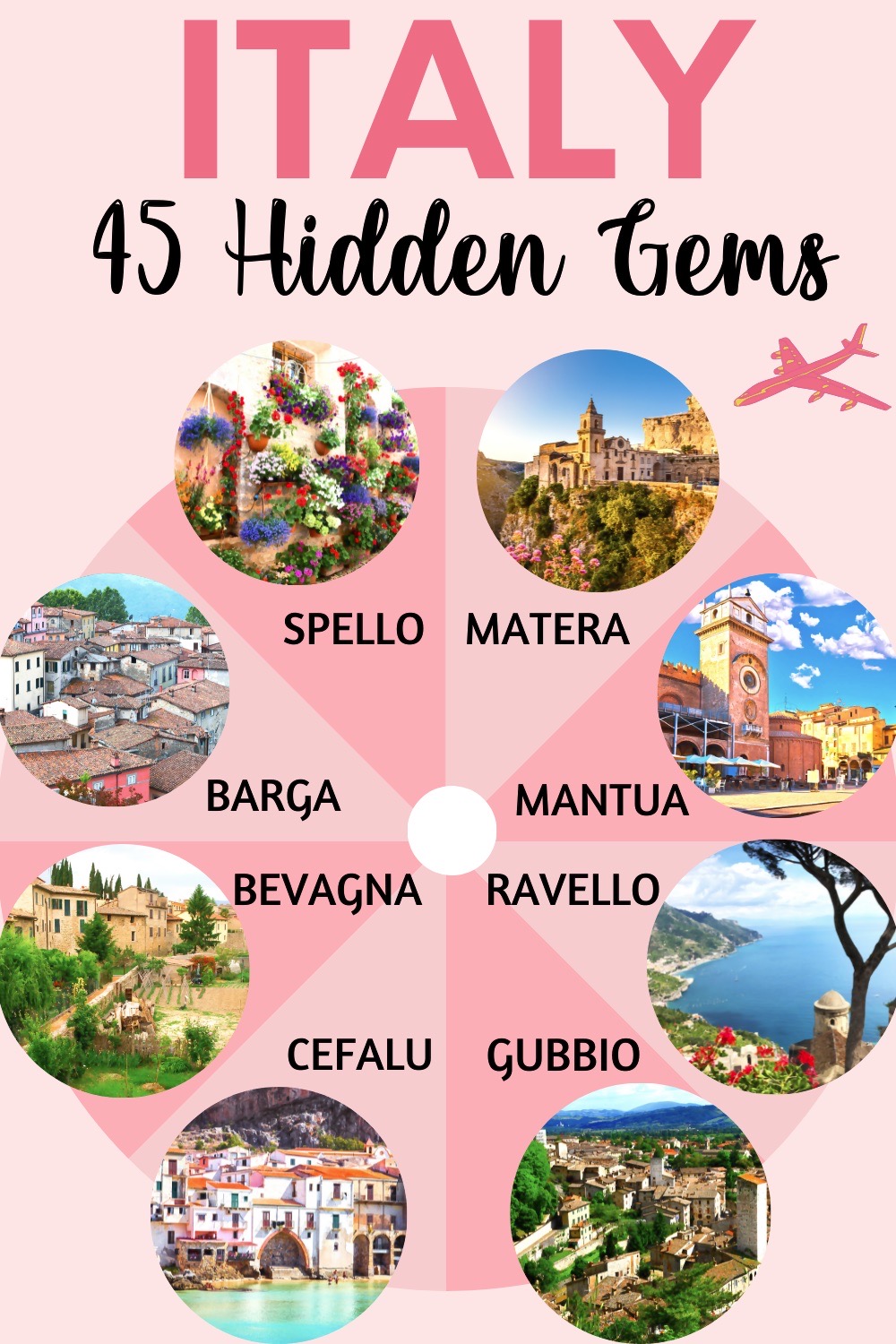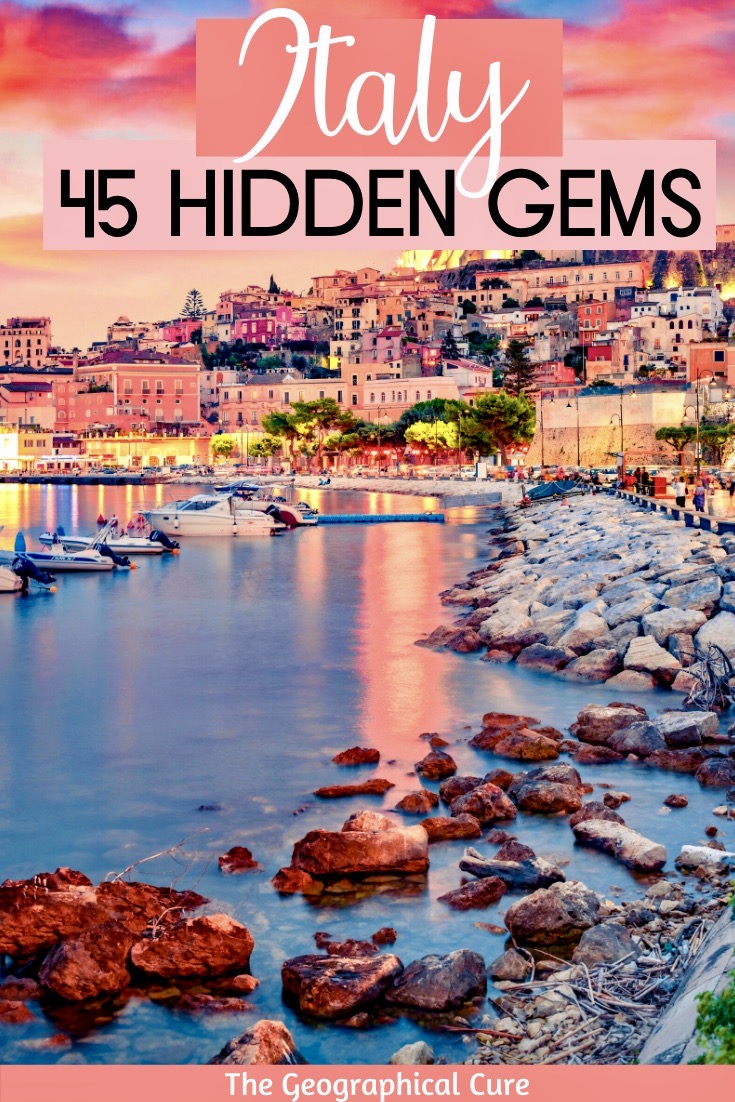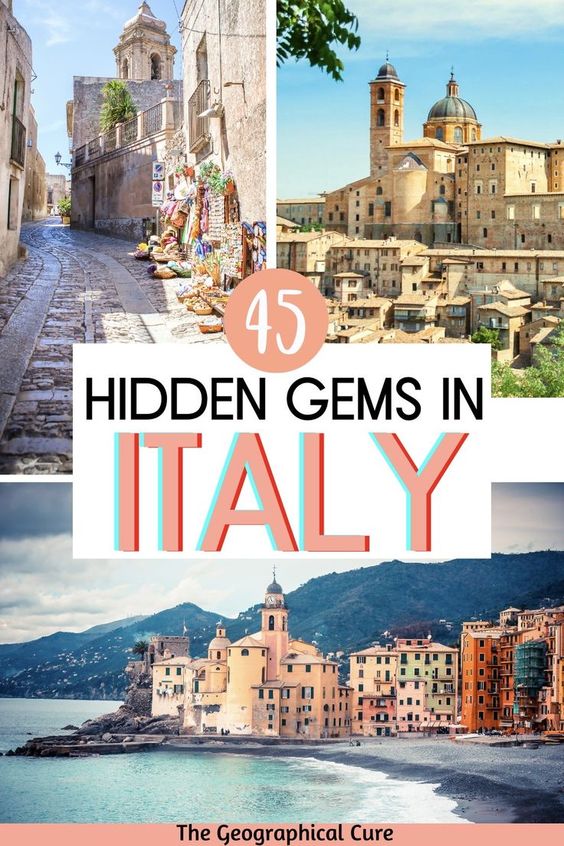Looking for some hidden gems in Italy? That’s a fantastic idea.
Many travelers tend to prioritize Italy’s famous cities over its more quaint medieval charmers, when in fact they should do the opposite. Italy’s lesser known secret towns are quaint, charming, and authentic.
From north to south, Italy is filled with picturesque less touristy hamlet that often go unnoticed and undiscovered. Some of these destinations are literally just a few steps off the classic tourist routes.
These frozen-in-time Italian villages will make you appreciate the beauty of taking it slow without the hustle and bustle of city life.
You can bask in medieval times without the crowds and lines that plague cities like Rome, Florence, and Venice.
45 Hidden Gems In Italy
Here are my picks for the best off the beaten path destinations and secret towns in Italy, for your bucket list. I’ve put them in alphabetical order for ease of reference.
1. Arezzo, Tuscany
The artsy town of Arezzo really shouldn’t be a hidden gem in Italy. But it’s incredibly underrated.
Arezzo is a lively place. It’s medieval core is compact and mostly pedestrianized, with a modern city set below.
Arezzo is everything you’d expect from an ancient Tuscan town. It’s a mini-tsunami of high culture, architecture, and history all set amid a cobbled old town.
The top attraction in Arezzo is the Basilica of San Francesco. It’s has a rough brick facade paired with an airy barn-like interior.
The church houses Arezzo’s top attraction, Piero della Francesca’s Legend of the True Cross fresco cycle.
It’s hugely important, considered one of the great and most influential frescos of the early 15th century.
The Cathedral of San Donatos also worth a visit. It’s an early Gothic church, dating from the 13th century.
It took over two centuries to build. The pointy bell tower, added in the 19th century, is the symbol of the city.
Art lovers should visit the Casa Vasari, the home of Giorgio Vasari, the famed Florentine architect and artist. Vasari was born in Arezzo and was a local hero. You’ll see his name everywhere.
Be sure to hike up to the Fortezza Medicea, a fine example of military architecture from the 16th century. From there, you’ll stunning 360 degree views of Arezzo and the surrounding countryside.
You may want to book a guided walking tour to get the lay of the land and learn about the top attractions. Arezzo is also a good place to take a food and market tour or pasta making class.
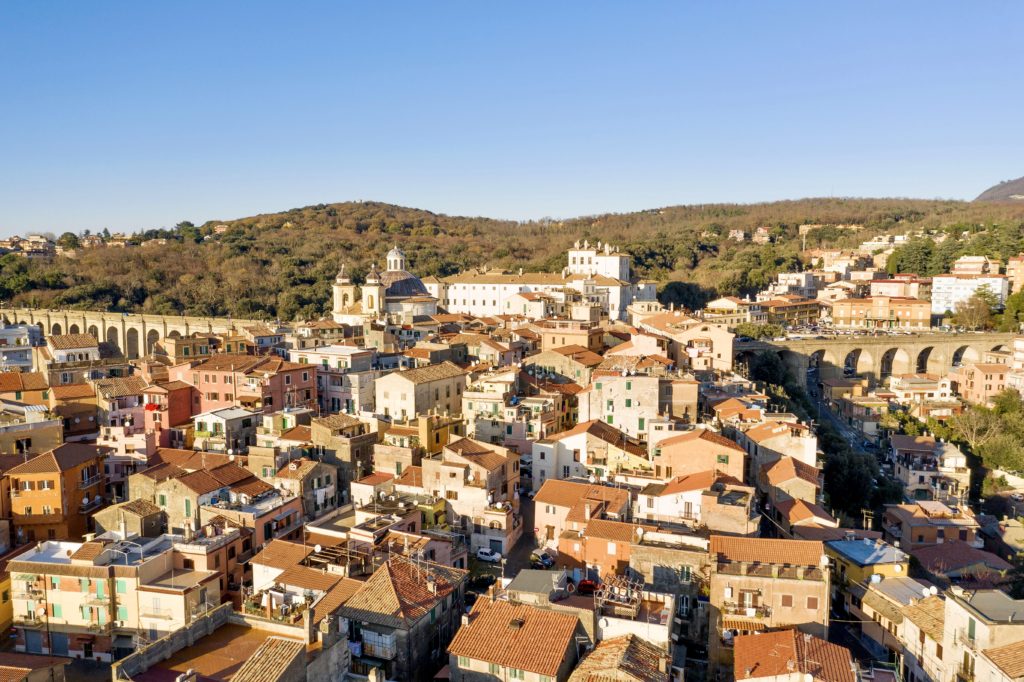
2. Ariccia, Castelli Romani
Ariccia is an artistic treasure in the Castelli Romani region, an area beloved by Romans. For centuries, Ariccia was a refuge for artists who came to these hills for inspiration.
Ariccia’s natural beauty captivated many wealthy Romans during the Renaissance. They were patrons to artists and architects such as Gian Lorenzo Bernini, the greatest sculptor of the Baroque era.
As a result, this small town is filled with architectural gems such as Palazzo Savelli Chigi, the church Santa Maria Assunta, and the Ponte di Ariccia.
The Palazzo Chigi is an impressive Baroque palace. It was renovated by Bernini for the Chigi family. They were a papal dynasty who also owned Villa Farnesina in Rome.
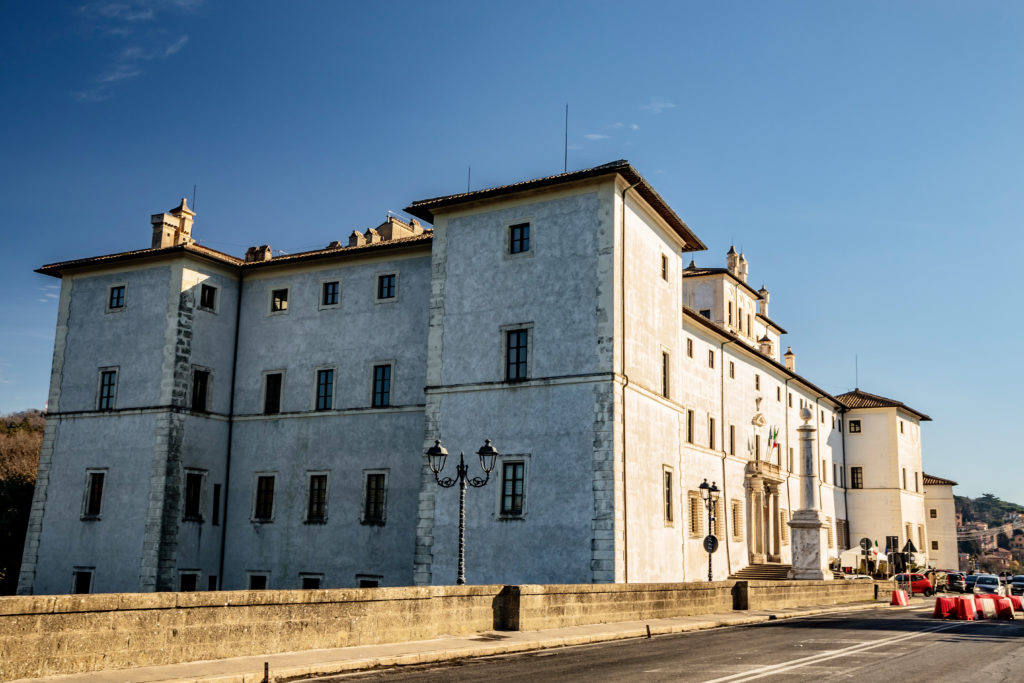
You can only visit the palace and see its grand rooms on a guided tour. The opulent palace is loaded with Baroque paintings and sculptures.
It’s been a filming location for many famous films, including the Visconti masterpiece The Leopard.
The Church of Santa Maria Assunta was also designed by Bernini. It was one his last works, inspired by Rome’s Pantheon.
Foodies will like Ariccia for its porchetta (roasted pork) and Romanello wine.
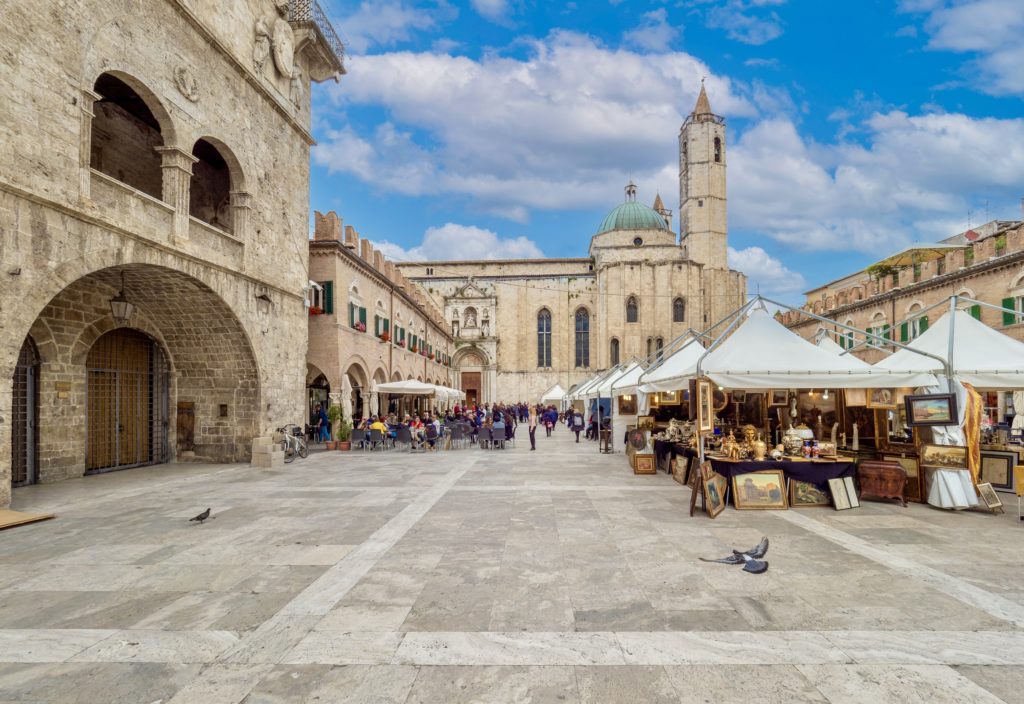
3. Ascoli Piceno, Le Marche
Le Marche is one of the most underrated Italian regions and Ascoli Piceno is one of its prettiest towns.
When you enter the city, you’re greeted by a massive double gate from the first century B.C., the Porta Gemina. Ascoli has lively squares, old monuments, and some interesting art.
Huddling within the town is a warren of gray-brown houses, with many square towers dating from the Middle Ages. The old quarter has cute crooked streets and travertine buildings.
Piazza dell’Arringo is the town’s political and religious center. Its east side is taken up by the Cathedral and a free-standing Romanesque baptistery.
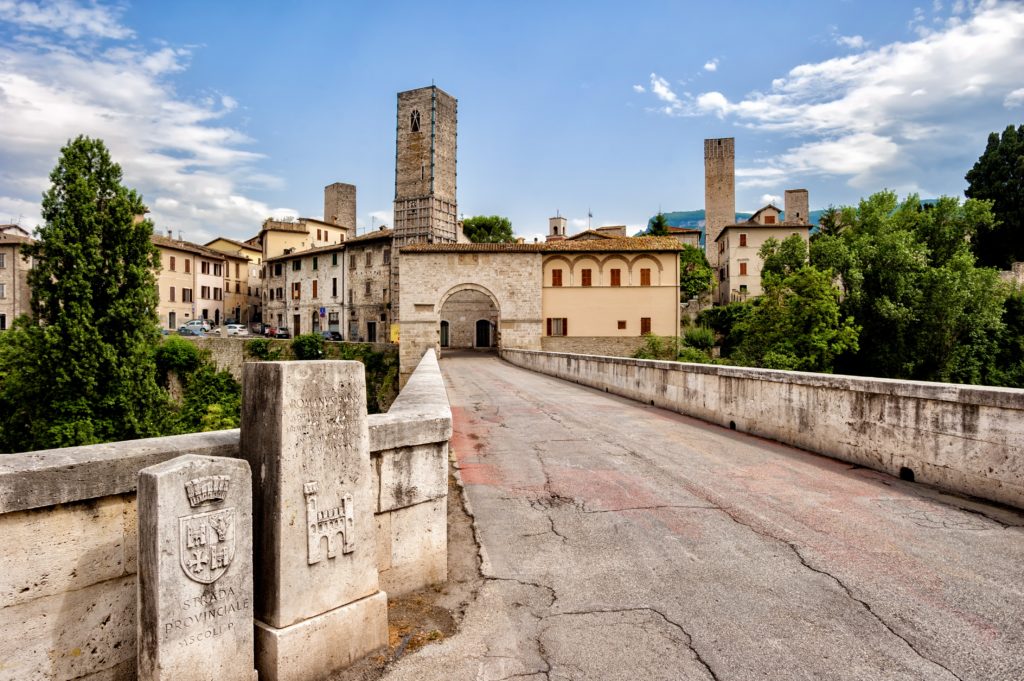
Started in the Romanesque style in the Middle Ages, it has a Gothic nave and a Renaissance facade that was never completed.
In the south of the piazza is the Bishop’s Palace and the Town Hall all, side by side. The Town Hall has a pinacoteca (picture gallery) on the second and third floors, with some 400 works by Canaletto, Reni, Turner Van Dyck and Rubens.
From the Piazza Dell’Arringo, it’s just a short walk Ascoli’s heart, the pedestrianized Piazza del Popolo. The square is lined with honey colored Renaissance buildings, including the 13th century Palazzo dei Capitani del Popolo.
To learn all about the art and history of Ascoli, you may want to book a guided walking tour. You can also visit on an e-bike tour or wine tasting tour.
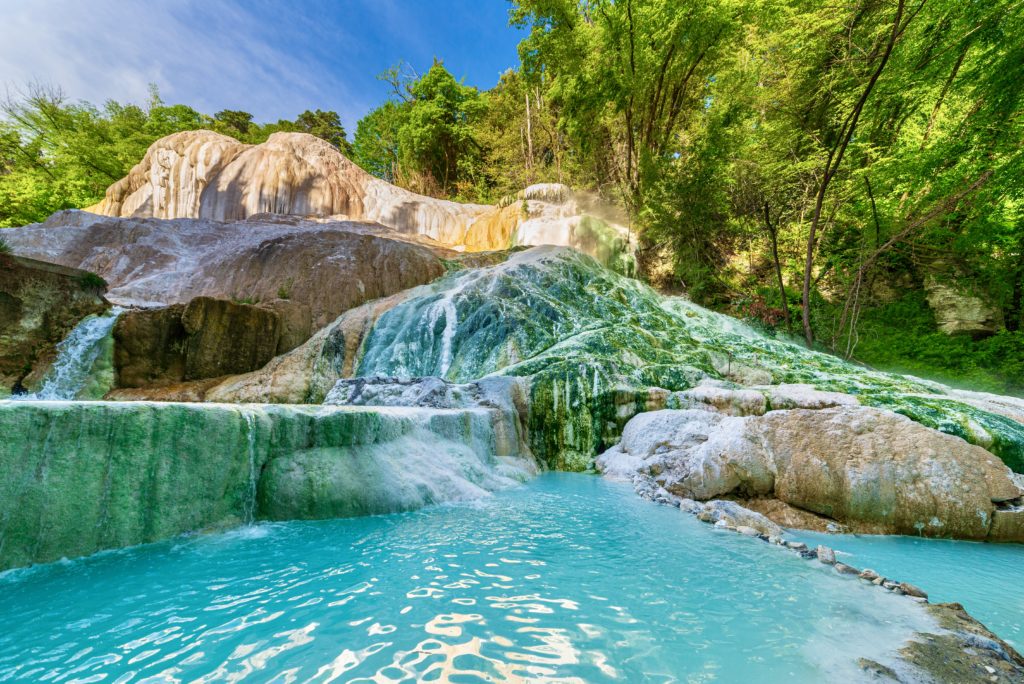
4. Bagni San Filippo, Tuscany
Need a good spa soak while you’re in Italy? Check out the small town of Bagni San Filippo, just 16 miles from Montepulciano in Tuscany.
The natural thermal baths are rich in minerals and make for a perfect spa day. The waterfall (nicknamed the “White Whale”) and hot pools are surrounded by forests. The springs are completely free to visit.
You can drive there in 30+ minutes from Montepulciano. Or, buses run three times a day from Montepulciano. So make sure to check the timetable and plan accordingly.
It’s best to visit in the morning when the steam rises from the sulfurous springs. It’s a magical sight.
5. Barga, Tuscany
If you want to escape the adoring crowds in Tuscany, head to the off the radar hidden gem town of Barga in the region’s northwest corner.
Barga is charming and very underrated as far as Tuscan villages go. Barga has a beautifully restored castle, an 11th century Duomo, and the beautiful Church of San Francesco.
You can wander around the cobbled old town in peace and quiet, without having to battle hordes of tourists. Along the way, you’ll discover secret passageways, tony boutiques, staircases, and pretty pastel homes. The homes are decked out with painted shutters and hanging flowers.
Barga’s Duomo is called the Collegiate di San Cristoforo, perched at the town’s highest point. The Duomo is free to enter, though you’ll have to pay a couple euros to light up the paintings.
If you need to grab a meal, try L’Osteria or Ristorante L’Altana.
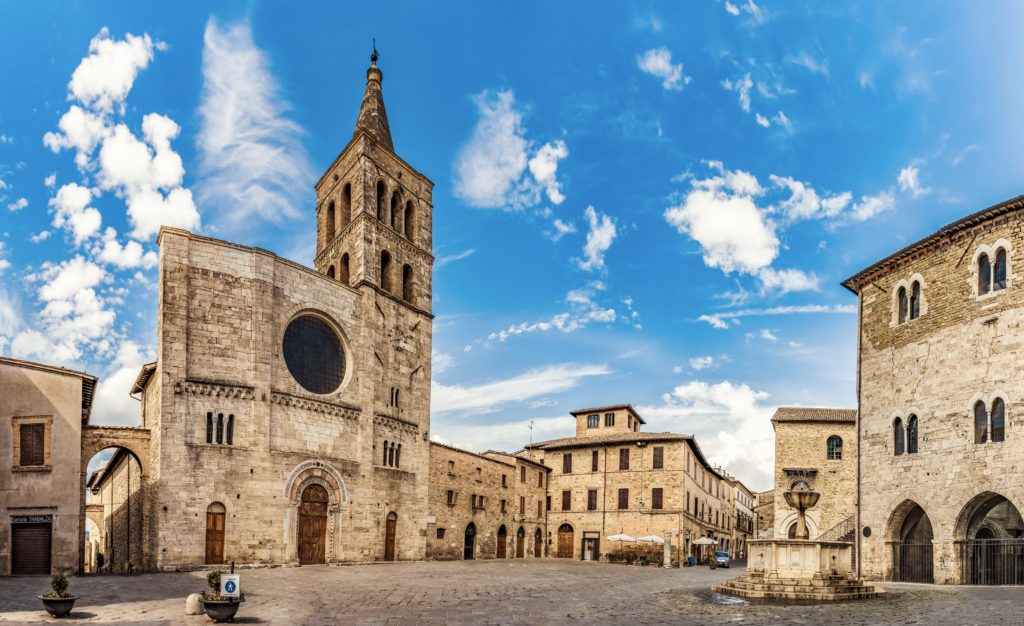
6. Bevagna, Umbria
The Umbrian town of Bevagna is a beautiful hidden gem in Italy that still bears signs of its Roman origins. In the 1st century, it was a Roman municipality on the Via Flamina.
A Roman arch, the Porta Foligno, beckons you into Bevagna’s cobbled streets . The quaint medieval town has Romanesque churches, Roman mosaics, a cinema ready piazza, and excellent trattorias.
Piazza Silvestri is the town’s central medieval square. It’s home to the 12th century Palazzo dei Consoli, the Collegiate Church of S. Michael, and the 19th century Teatro Torti.
The most important Roman landmarks in Bevagna are the Roman Theater and the Roman Temple. The temple is where you’ll find black and white mosaics dating from the 2nd century mosaics depicting sea creatures.
A good place to eat in Bevagna is La Bottega di Assù. You can also book an olive oil tasting tour, to try out Umbria’s “green” olive oil. Or, take a combination biking and food tour.
READ: One Week In Umbria Itinerary
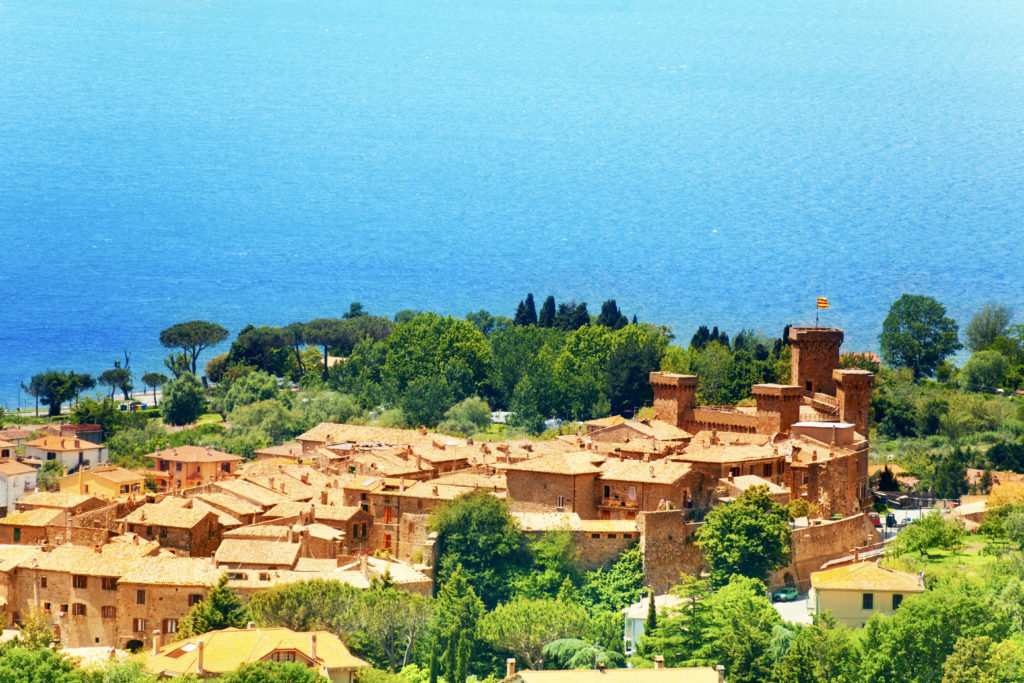
7. Bolsena, Lazio
Bolsena is a pretty hidden gem town in Italy on Lake Bolsena. It’s possible to enjoy a wide range of activities, depending on your interest.
Set on Italy’s largest volcanic lake, Bolsena has a relaxing and romantic quality. The town is secluded and close to nature. You can hike, swim, or just relax.
Bolsena is also an ancient Etruscan settlement. It’s home to a large necropolis with tombs and funerary ornaments, which attracts history buffs and archaeologists.
The historic center is picture perfect. Bolsena’s main monument is the Cathedral of St. Cristina. It’s dedicated to an 11 year old girl who was martyred during the reign of Roman emperor Diocletian.
You can also visit the Castello Monaldeschi. The castle was built during the 12th and 14th centuries.
It now houses the Lake Bolsena Museum. The museum gives you an overview of the region’s history.
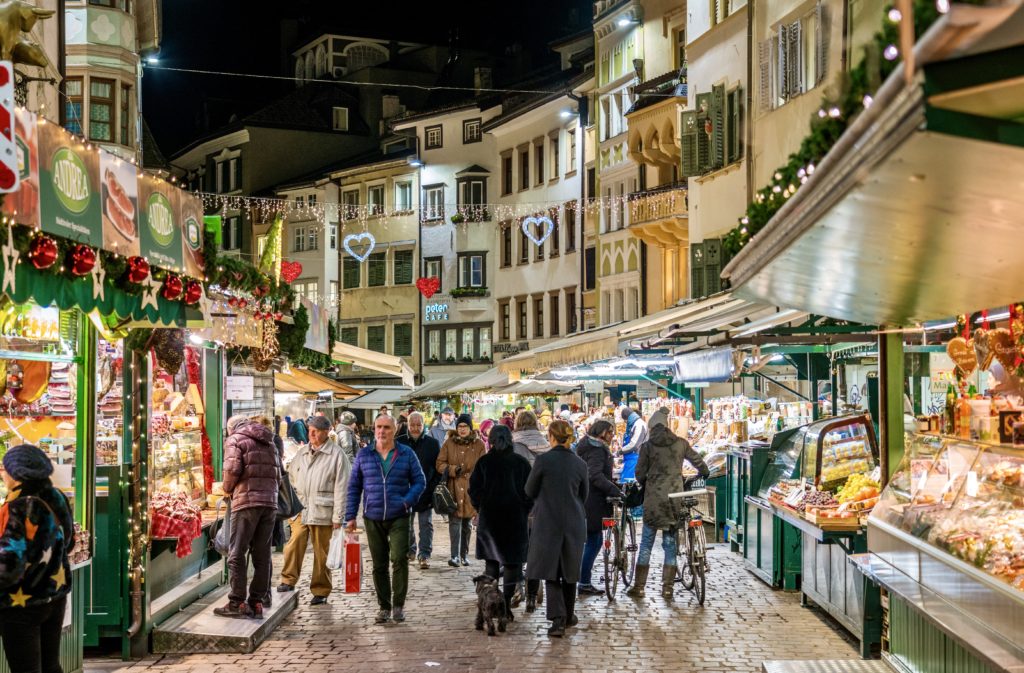
8. Bolzano, Alto Adige
Bolzano is a pretty town on the foothills of the Dolomites in northern Italy. Its painted houses and flowering balconies give it a fairytale vibe.
The prettiest spot in town is the Piazza delle Erbe, a small piazza in the heart of Bolzano. The piazza and the lanes surrounding it boast fantastic Austrian style architecture.
Another pretty square is Piazza Walther. The piazza is full of cafes and bars. This is where the annual Christmas market is held.
Be sure to visit the Duomo on the piazza, the Church of Santa Maria Assunta. With its multicolored roof of green and yellow, it’s the most distinctive landmark in Bolzano. It has a wonderful gothic tower with beautiful carvings.
Bolzano is also home to pretty porticoes, which you’ll find in the town center and and on the Via dei Portici. The covered passages are full of boutiques, bakeries, and Austrian-style cafes.
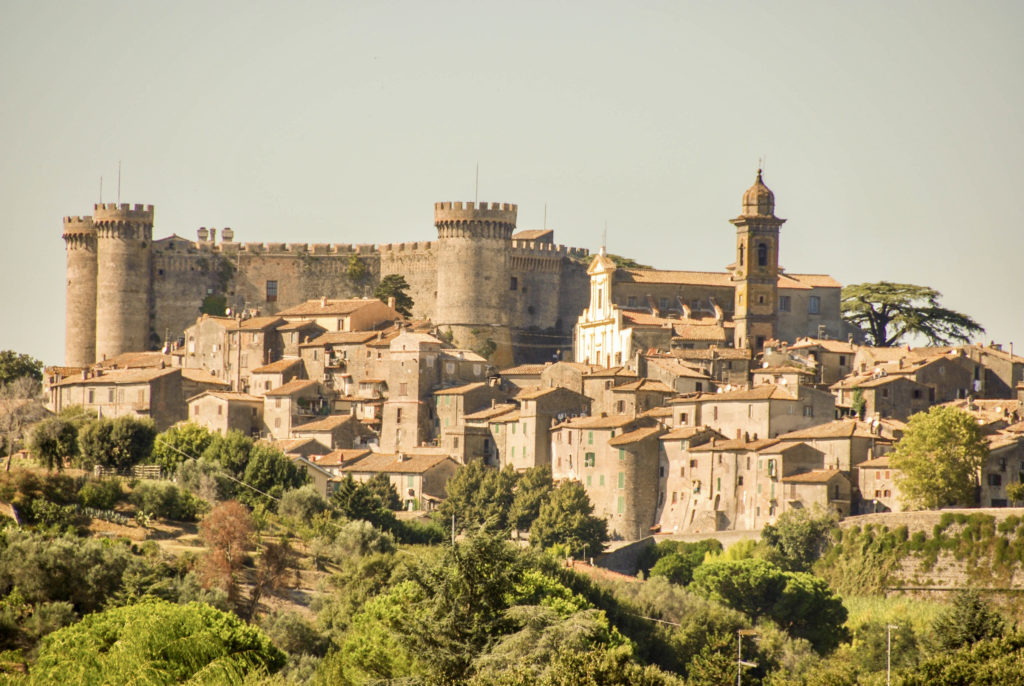
9. Bracciano, Lazio
Bracciano is located on the shores of the volcanic Lake Bracciano. It’s a lovely small medieval town. Piazza IV Novembre is the main square.
Bracciano used to be a simple fishing and farming village. But in the 15th century, the pope gifted the town to the powerful Orsini family. They built the local castle, now known as Odescalchi Castle.
This castle is one of the few Renaissance castles in Italy. You’ll find medieval interiors, artifacts, and period furniture. From the top, you’ll have beautiful views of Lake Bracciano.
Other attractions in Bracciano include the beautiful Santo Stefano Cathedral and Church of St. Liberato. The lake and nature reserve are a perfect place for a relaxing walk.
10. Brescia, Lombardy
Nestled at the foot of the Alps in northern Italy, just a few miles from Lake Como, Brescia is a hidden gem in Italy chock full of impressive monuments.
Your first point of call is Piazza Paolo VI, formerly called Piazza del Duomo. The square holds not one but two cathedrals.
The Old Cathedral, locally known as Duomo Vecchio, is truly incredible. Building began in the 11th century, with much subsequent construction.
The New Cathedral, with Baroque and Neo-Classical designs, was built in the 17th and 18th centuries. It boasts one of Italy’s biggest domes.
Piazza della Loggia is another beautiful and elegant square. It’s surrounded with Venetian style buildings, including the Renaissance Palazzo della Loggia.
Another must see site in Brescia is the Tempio Capitolino, built by Emperor Vespasian in 73 A.D. It was dedicated to the Gods Juno, Jupiter and Minerva. Six of the ancient columns still stand.
>>> Click here to book a guided walking tour of Brescia
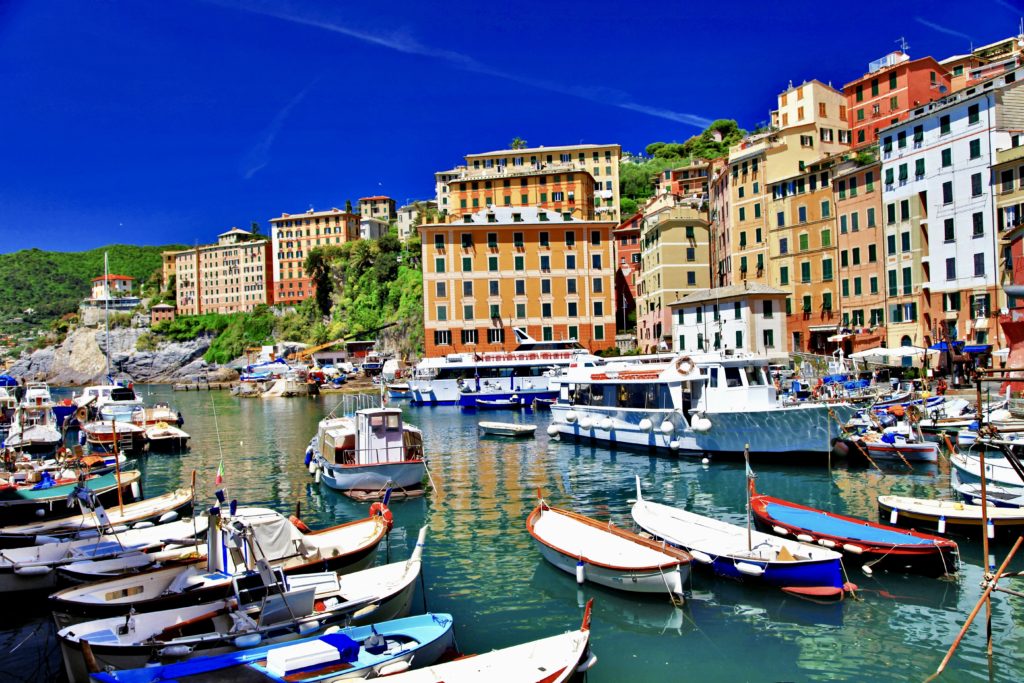
11. Camogli, Liguria
Camogli is a hidden gem in Italy set on the electric blue waters of the Ligurian sea on the Italian Riviera. While Americans head to Portofino, Camogli is just for the Italians.
Camogli has the vibe of an old fishing town. It’s setting is gorgeous.
Pastel Genovese-style homes are stacked up on a steep hillside in reds, yellows, and oranges. Fishing boats fill the harbor.
Camogli is clustered around its waterfront. A seaside promenade runs the length of the town.
The main street is the steep Via XX Settembre, filled with shops. While in Camogli, be sure to try the town’s famed focaccia and have some seafood at Vento Ariel.
You can visit Camogli (and other towns on the Ligurian coast on a guided day trip from Genoa. I also recommend the 3 hour street food tour.
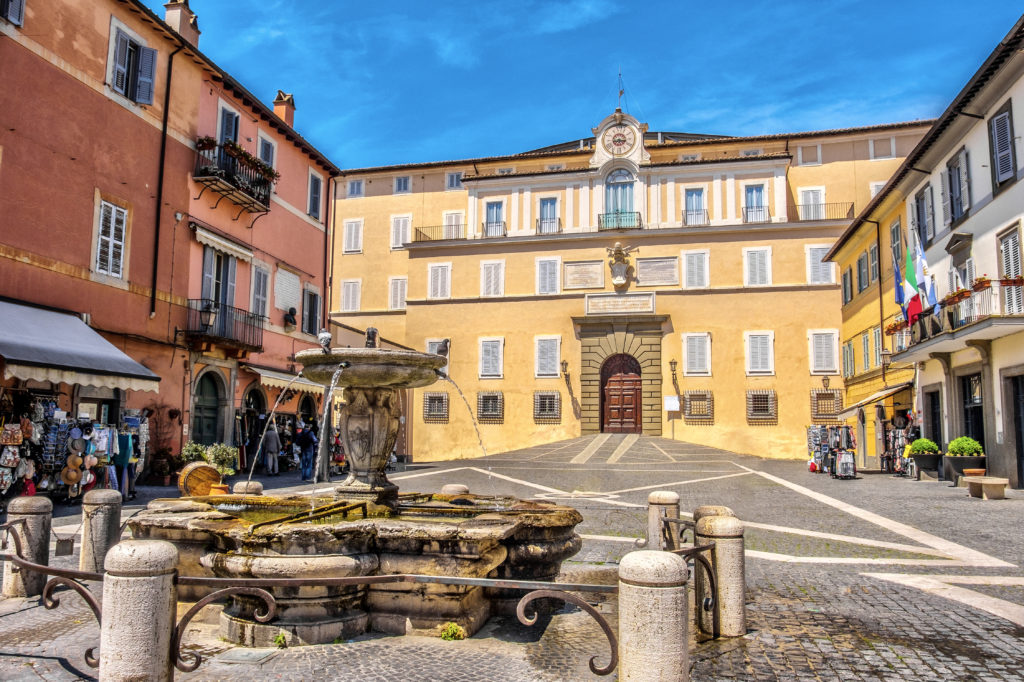
12. Castel Gandolfo, Lazio
Castel Gandolfo is secret Italian town set amid the Alban Hills, with lush wooded hillsides. It looks out over the tranquil Lake Albano.
For centuries, the town has been home to the the pope’s summer palace. The Pontifical Villas cover almost 136 acres (more than Vatican City).
You may remember the palace and its magnificent gardens from the Netflix movie The Two Popes.
The 17th century Apostolic Palace is a sight to behold.
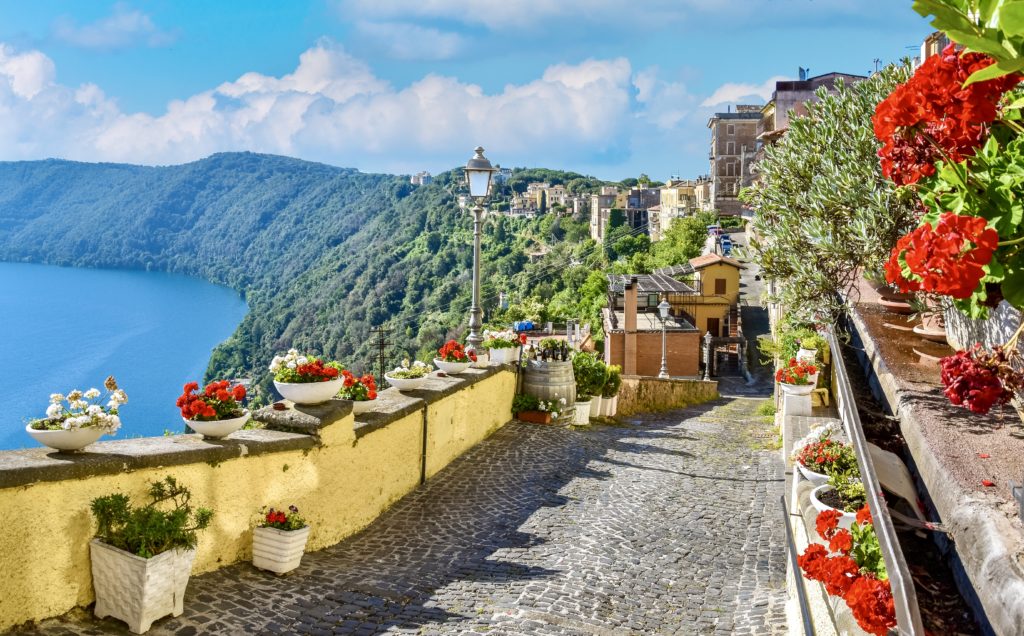
Inside, it’s ornate and richly decorated. Pope Francis opened the palace as a museum in 2014. There are seven rooms open for visitors to explore.
There are several stunning papal gardens, including the Barberini Gardens, Giardino della Madonna, and the Belvedere Gardens.
The Belvedere is the most famous. It even has an ancient Cryptoporticus built by Emperor Domitian.
There are some other landmarks in town to admire. In particular, Bernini designed the Church of San Tommaso da Villanova.
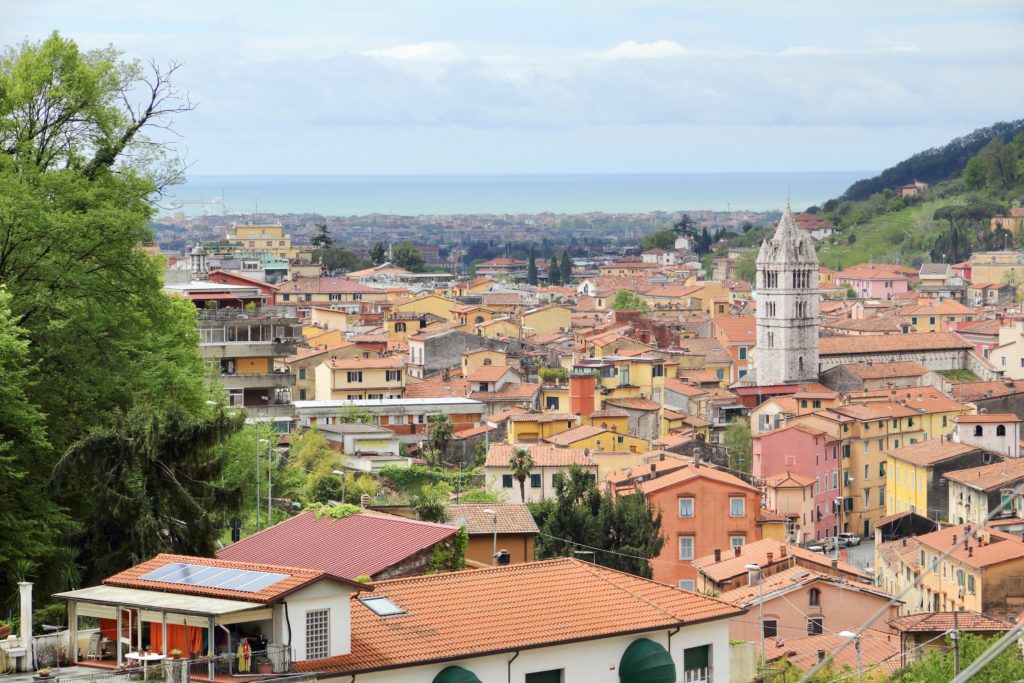
13. Carrera, Tuscany
The “marbelous” town of Carrera is synonymous with its marble quarries. For centuries, the massive quarries have yielded the raw material used by Italian sculptors like Michelangelo or Bernini.
Carrera marble was used to build the Pantheon in Rome and to create a sculpture you may have heard about, Michelangelo’s famous David.
The town itself is lovely, with colorful buildings and marble everywhere. The center is Piazza Alberica.
Carrera has a fine 12th century cathedral, the Cathedral of Sant’Andrea, in Piazza del Duomo. In the same square, you can also admire the Fountain of Giants.
You can also visit the Museo del Marmo, an interesting marble museum.
You can even see some of the marble mines at closer hand. Just follow signs from Carrera for Strada Panoramic per Le Cave. You can also explore the quarries on an off road jeep tour.
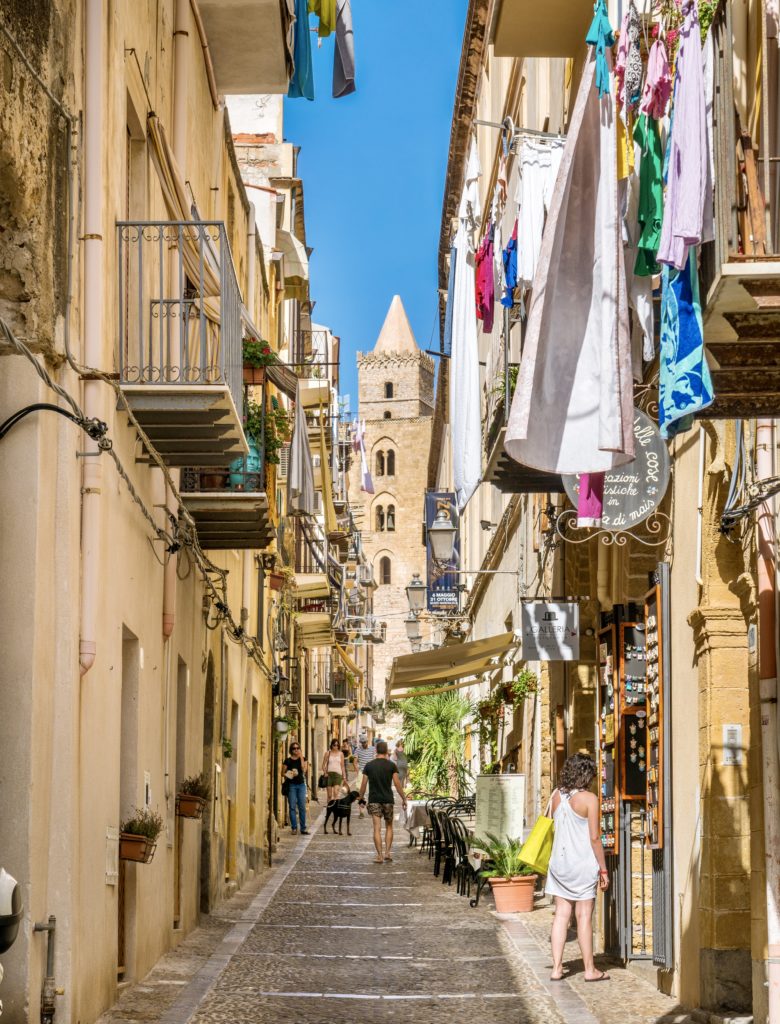
14. Cefalu, Sicily
Cefalu is home to one of Italy’s finest crescent-shaped beaches. It’s the perfect place to relax and unwind for a few days without crowds.
Plus, the town of Cefalu is postcard perfect. The medieval town has lovely honey colored buildings, pretty piazzas, and some fine churches. Its port is lined with fishing boats and the seafront promenade is perfect for the evening passeggiata.
Cefalu Cathedral is located in the Piazza del Duomo. It’s a 12th century Arab-Norman architecture masterpiece. Its apse is adorned with elaborate Byzantine mosaics. The cloisters have graceful arches and ornately carved capitals.
If you’re up for a hike, take the 30-45 minute steep walk up to La Rocca, Cefalu’s mountain. The path is well sign posted. You’ll be rewarded with 360 coastal views from the “top of the rock.”
You can visit Cefalu on a guided day trip from Palermo. If you’re a thrill seeker, you can go paragliding or mountain biking.
READ: 2 Weeks In Sicily Itinerary
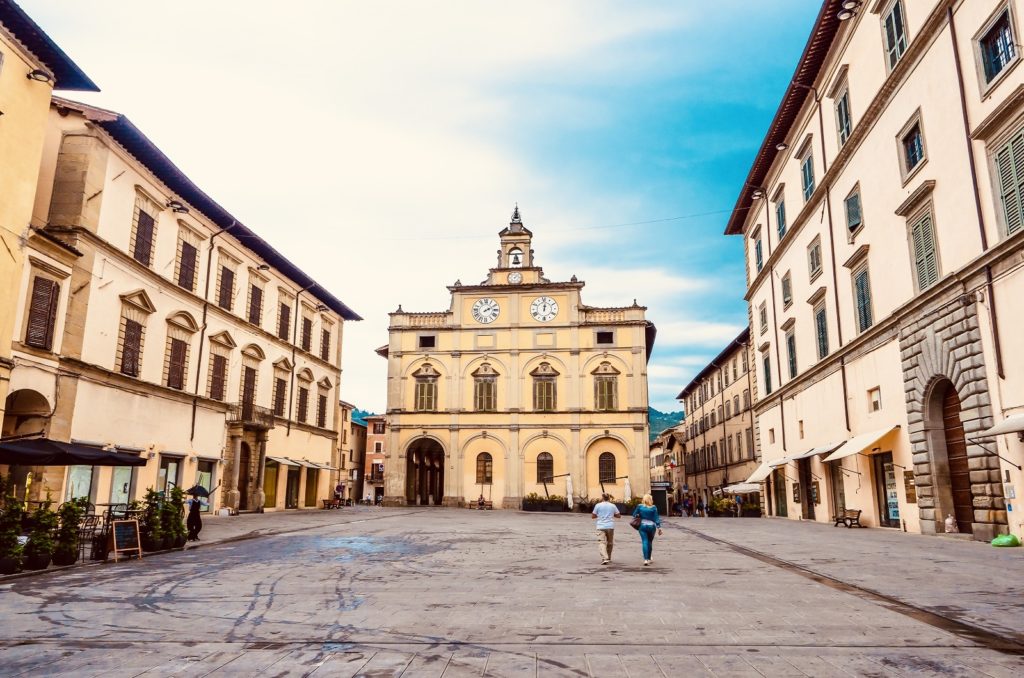
15. Città di Castello, Umbria
Citta di Castello is a hidden gem in Italy just north of Perugia in Umbria. The tiny walled town is a small capital of the arts. It was embellished by artists like Luca Signorelli, Raphael, and Vasari, who enjoyed long sojourns in the town.
Unlike other medieval towns in Umbria, Citta di Castello is pure Renaissance. Its broad streets are filled with 16th century Renaissance palazzi.
The town’s monumental Duomo is in the Piazza Gabriotti. It was built in the 11th century, but enlarged and remodeled in the 15th to 16th centuries.
The large complex next door houses the Duomo Museum, where you’ll find paintings by Rosso Fiorentino.
The Palazzo Vitelli was designed by Vasari and was a symbol of the power of the Vitelli family. The palace houses a small art gallery of some distinction, with paintings by Raphael, Signorelli, and Ghirlandaio.
The town is also on the antique market circuit.
16. Civita di Bagnoregio, Lazio
The village of Civita di Bagnoregio is just 30 minutes from Orvieto. Of all the stunning hill towns in Italy, Civita di Bagnoregio may be the most dreamy and surreal.
The tiny village is like an architectural stage set suspended in midair. It’s a marvel that teeters on a tufa hilltop in a vast canyon.
You can only reach the ancient village via a dramatic cantilevered bridge, which rises steeply to meet the village walls.
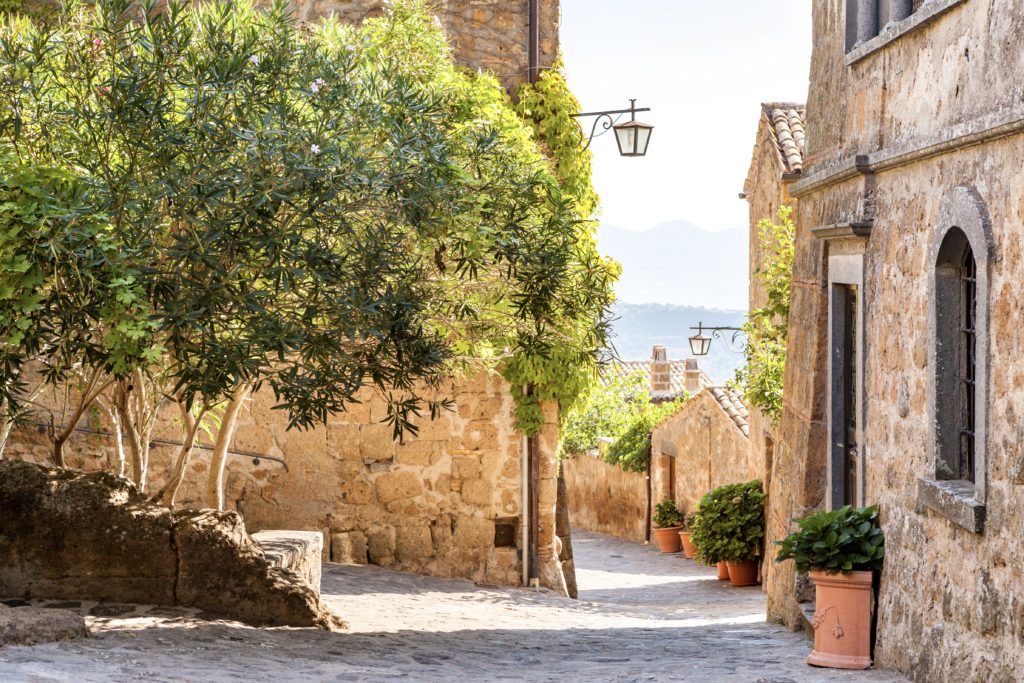
Once inside the village, the charms of Civita are subtle. There’s nothing special to do but wander around in this step-back-in-time rural village. It’s just romantic and unadulterated old world Italy.
Stroll aimlessly down charming lanes, where every nearly every inch of space is festooned with flowers.
Have a seat on the steps of San Donato Church. Admire the flowerpots and warm stone walls that glow in the sunshine.
Here’s my complete guide to visiting Civita di Bagnoregio. If you’d like a guided tour of the town’s sites and history, you can check out this 1.5 walking tour.
17. Fiesole, Tuscany
Located high above uber popular Florence in the Tuscan countryside, Fiesole is one of the easiest day trips from Florence. You can actually walk there in an hour.
If you don’t want to hoof it, there’s a bus that leaves from Florence as well. You could easily wile away a half day in Fiesole.
If you’re a ruin luster or history buff, Fiesole is perfect. Fiesole pre-dates Florence, with Etruscan roots from the 8th to 9th century B.C. Be sure to visit the Etruscan-Roman Archaeological site, including a Roman amphitheater, Roman baths, and remains of Etruscan walls.
Also check out the the Monastery of San Francesco. This is the town’s highest point, with a wonderful panoramic view of the town. Fiesole’s beautiful cathedral, the Cathedral of San Romolo, is ancient, almost a thousand years old.
And don’t forget the Bandini Museum, housed in a local church. It has a surprisingly good collection of art curated by local 18th century cleric Angelo Bandini. There are some beautiful late Gothic pieces and ceramics by Luca della Robbia.
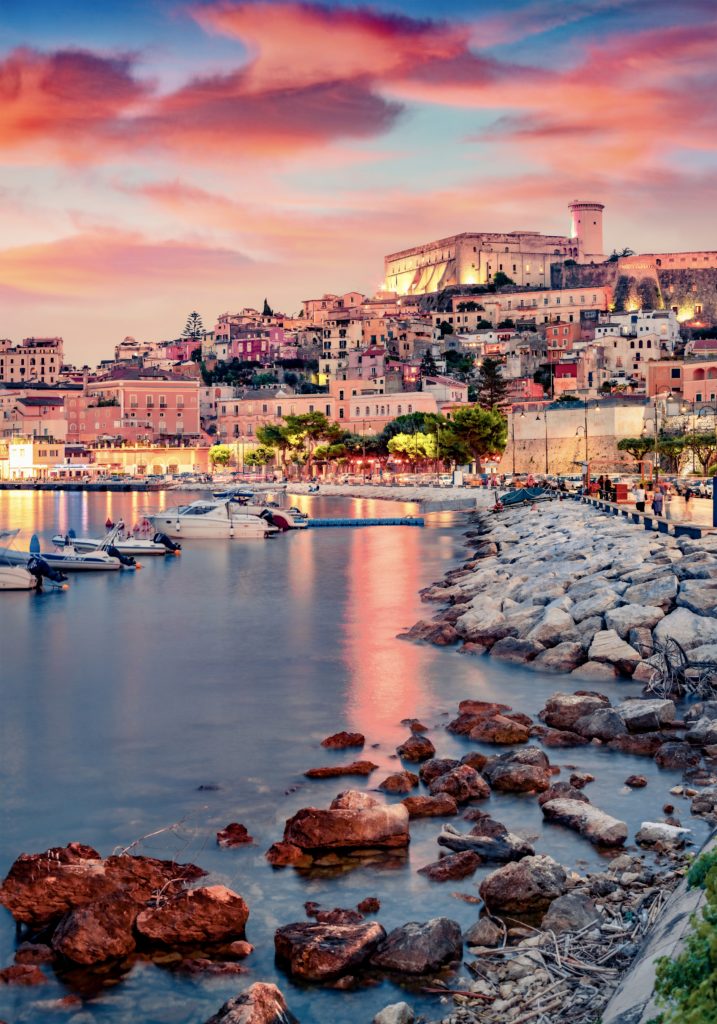
18. Gaeta
Gaeta is a pretty town that’s the perfect seaside day trip from Rome. Gaeta has a well-preserved medieval historic center and a beautiful natural setting overlooking the Tyrrhenian Sea.
Serapo beach is a fantastic golend sand beach, definitely one of the best beaches near Rome. Sant’Agostino Beach is a great place for surfing.
The 6th century Aragonese Castle is the most distinctive feature of the Gaeta skyline.
Gaeta is also known as the “city of 100 churches.” The Byzantine-style Church of St. Francesco is the most stunning one. Geata’s Duomo has some beautiful art inside and an elegant Norman bell tower.
Gaeta is also home to Mount Orlando. If you hike up, you can explore the Sanctuary of the Split Mountain and a famous grotto. You’ll have stunning views of the Mediterranean. There’s an entrance to the park on Serapo Beach.
You may want to book a guided walking and food tour for your visit.
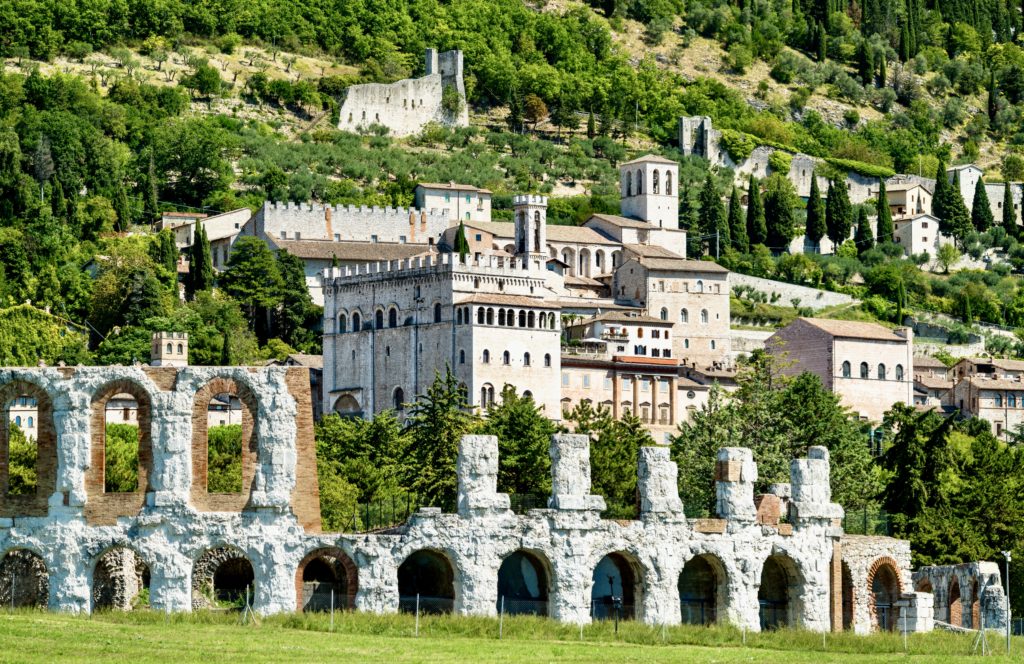
19. Gubbio, Umbria
No list of hidden gems in Italy would be complete without including the town of Gubbio. It’s a gorgeous stony town in northeast Umbria. It stands virtually alone in the perfection of its medieval setting.
Gubbio is practically carved into the side of Mount Ingino. Gubbio is an off the beaten track gem in Italy where you can bask in medieval heritage without crowds.
Gubbio is a spectacular vision of monumental buildings. The stony town seems trapped in the Middle Ages, with block after block of pinky-beige Romanesque and Gothic architecture.
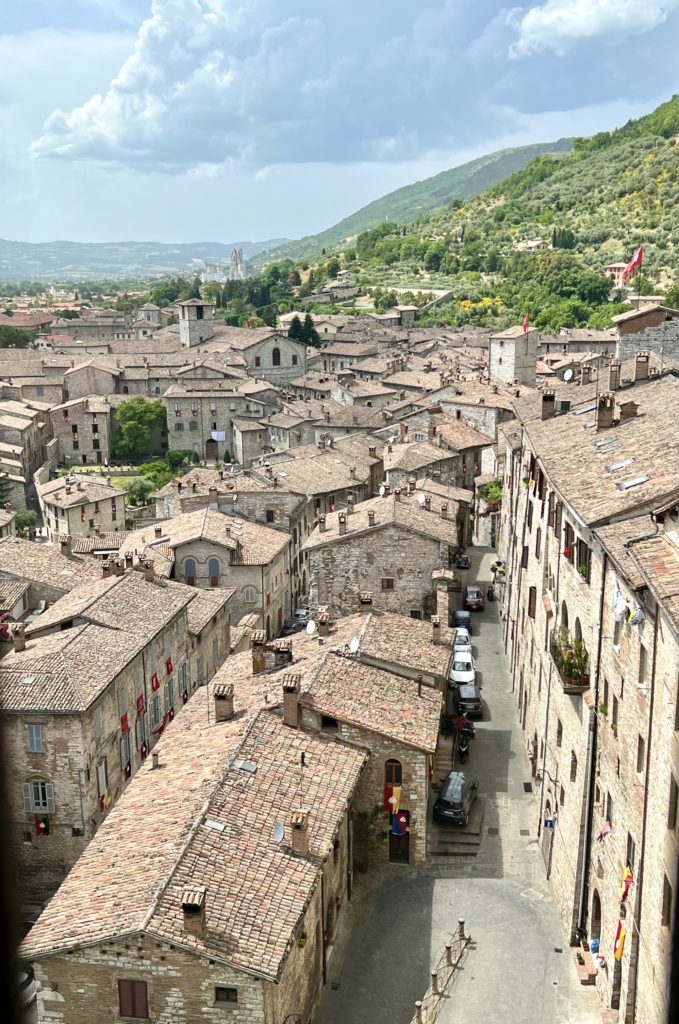
Gubbio is famous for its Roman ruins, beautiful Piazza Grande, and the thrill-inducing funicular ride up to the Basilica of Saint Ubaldo.
The 14th century Palace of the Consuls is a striking and well preserved medieval civic building. It houses the town’s Civic Museum, including the ancient bronze Iguvine tablets.
Here’s my complete guide to the best things to do in Gubbio. If you want the full scoop on Gubbio and its history and monuments, you may want to book a guided walking tour.
You can also book a guided street food tour. Or, take a pasta making class or a pizza and tiramisu making class.
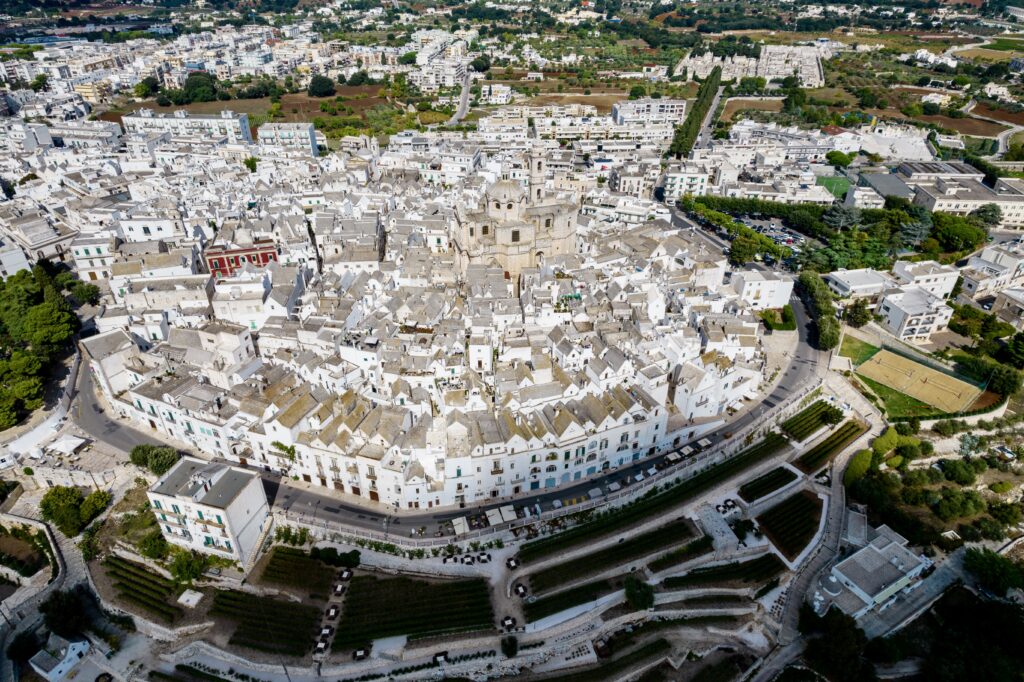
20. Locorontondo, Puglia
Locorotondo is known as the “Most Beautiful Borgo in Italy.” It’s a delightful town perched on a hill, offering breathtaking views of Puglia’s entire Itria Valley. Unlike its more famous neighbor, Alberobello, Locorotondo manages to maintain its charm without being overrun by crowds.
The town’s name itself, Locorotondo, meaning “round place,” perfectly captures its character. The historic center consists of concentric rings of pristine white houses, creating an enchanting architectural ensemble.
While Alberobello is renowned for its trulli, Locorotondo stands out for its cumerse homes. These traditional houses are constructed using the same local stone.
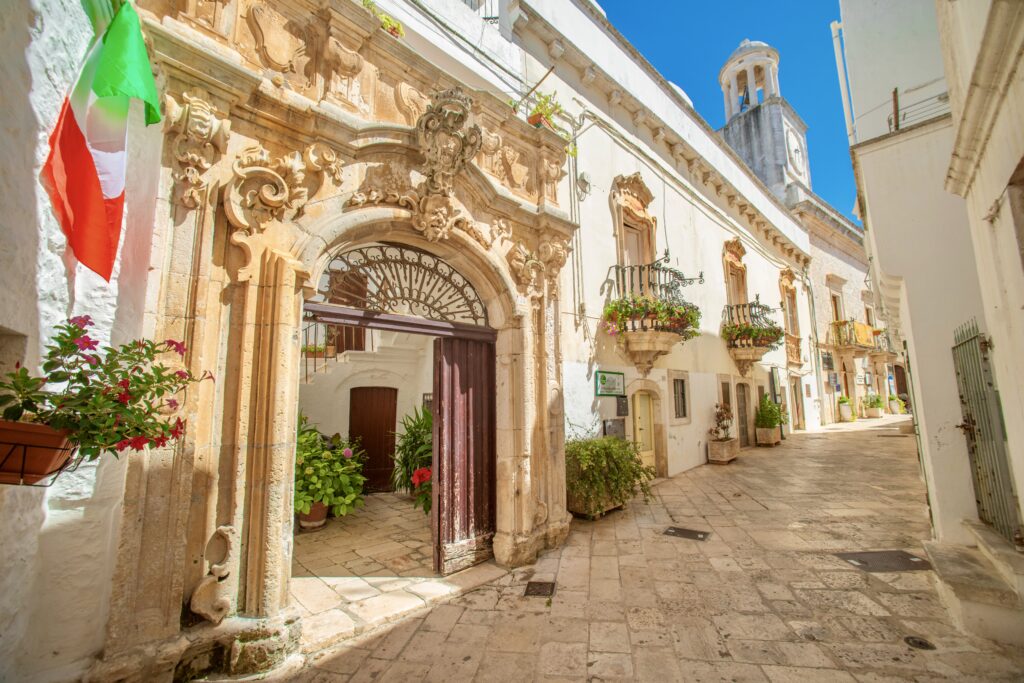
But what sets them apart are the pointed gable roofs meticulously fitted and aligned with the front facades of the buildings. It’s a testament to the town’s commitment to preserving its distinctive heritage.
One of the star attractions in Locorotondo is the San Giorgio Church, located in the heart of the historic center. This remarkable church, built between 1790 and 1825, boasts a magnificent 115-foot dome and a bell tower that can be admired from every corner of the town.
Stepping inside, you’ll be greeted by a painting of St. George and a splendid marble altar.
As you wander through Locorotondo, you might also consider visiting the St. Nicola Church. The main draw here is the mesmerizing frescoed ceiling, a true visual feast for art enthusiasts and history aficionados.
>>> Click here to book a guided tour of Locorotondo
21. Mantua, Lombardy
Italy is usually overflowing with tourists. But in the tiny undiscovered village of Mantua the world is still and quiet. Mantua must surely be one of Europe’s best kept secrets.
Mantua lies in the north of Italy in the Lombardy region, surrounded by three lakes. It’s a fairly easy day trip from Milan or Verona.
Mantua is the perfect place for strolling — with arcaded streets, cobbled lanes squares, and dreamy Renaissance architecture.
Mantua’s most famed site is the Ducal Palace or Palazzo Ducale. It’s a massive fortress-like residence. Inside, there’a maze of 600 ornate gilded, frescoed, and marbled rooms, topped with a Hall of Mirrors.
You’ll see Andrea Mantegna’s famous UNESCO-listed Camera degli Sposi . It’s a magical room frescoed with illusionistic paintings.
It’s a hugely influential masterpiece from the Early Renaissance, considered the first trompe l’oeil in the history of painting.
You should also visit Te Palace. It’s a wildly inventive and theatrical feat of both architecture and decoration. It was designed and frescoed by Raphael’s best pupil, Giulio Romano, between 1525-35.
You can take a 2 hour guided walking tour of Mantua or a longer private walking tour. You can also book a guided tour of the amazing Ducal Palace.
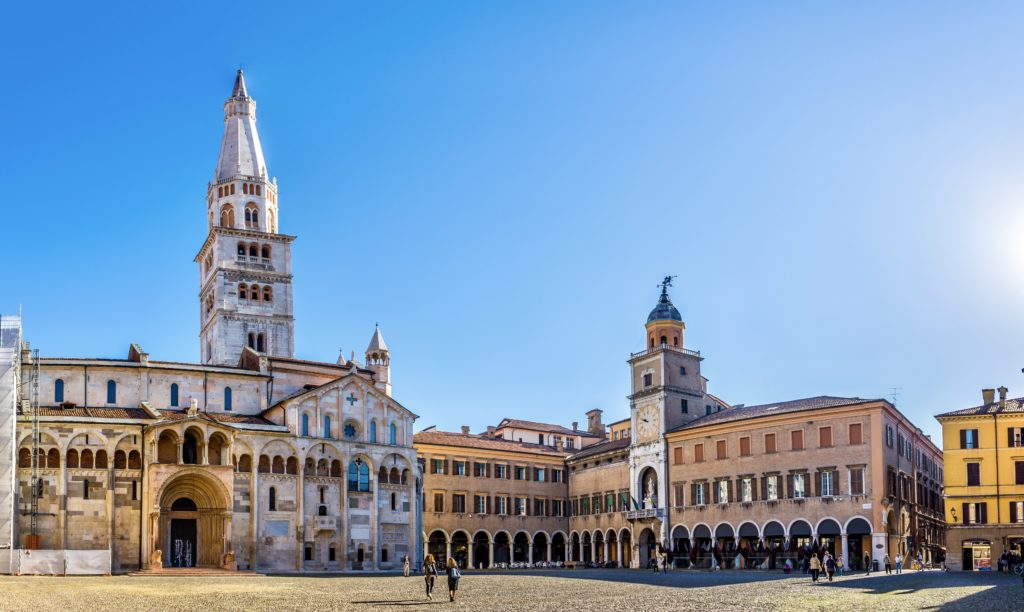
22. Modena, Emilia-Romagna
Modena is a hidden gem in Italy, just a half hour from Bologna. It’s an elegant little city that’s well worth a visit.
Modena is a foodie haven. It’s famous for hams, cheeses, and barrel aged balsamic vinegar. You can sample the dark elixir in shops around the town.
Piazza Grande is its beautiful main square. It’s home to several monuments, including a Duomo, town hall, a picturesque 15th century clock tower, and medieval relics.
The 12th century Duomo is one of the finest examples of Romanesque architecture. It comes complete with a slightly leaning bell tower called the “Ghirlandina.”
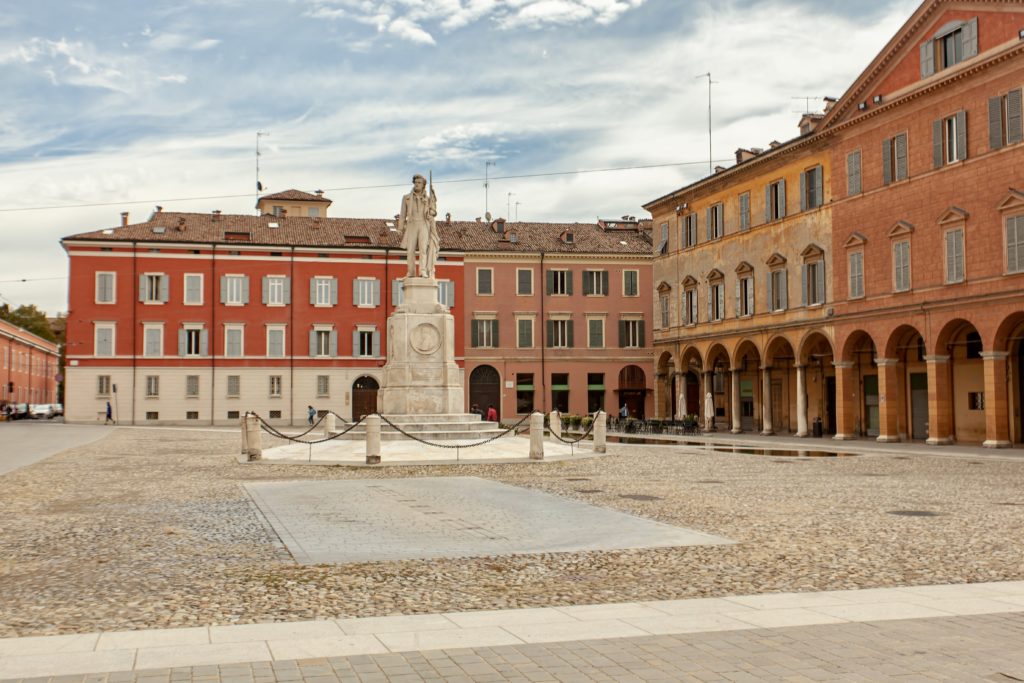
Modena is also known as the “Land of Motors” because all of Italy’s sports cars are manufactured there and the facilities are open to the public.
Maserati has 20 vintage cars on permanent display. The Museo Ferrari has vintage and modern Ferraris on display. And the Museo Lamborghini is just outside of town.
Modena was also the birthplace of Luciano Pavarotti. His titular museum, Luciano Pavarotti Museum, is located about 20 minutes from city center on the estate where the famous tenor lived.
Since Modena is for foodies, you may want to book a guided food tour, do a balsamic vinegar tasting, or tour Italy’s most famous cheese factory.
23. Montalcino, Tuscany
Montalcino is a pretty village of medieval perfection. It’s crowned by a fairytale castle, blessed with magnificent views, and edged with vineyards.
It’s known for its Brunello wine, one of the world’s most beloved reds.
Montalcino is a superstar wine region, and a bit off the beaten track by Tuscany standards. While in Montalcino, you can have wine tasting and lunch at a medieval castle or take a 3 hour tour of the Brunello vineyards.
Montalcino’s historic center has barely changed in centuries. The main square is the Piazza del Popolo, with a Gothic loggia and clock tower.
The town is dominated by the mighty and imposing Rocca fortress, which was built in 1361 when Montalcino was captured from Florence by Siena. From the ramparts, you’ll have spectacular views. The fortress also has a tasting room for oenophiles.
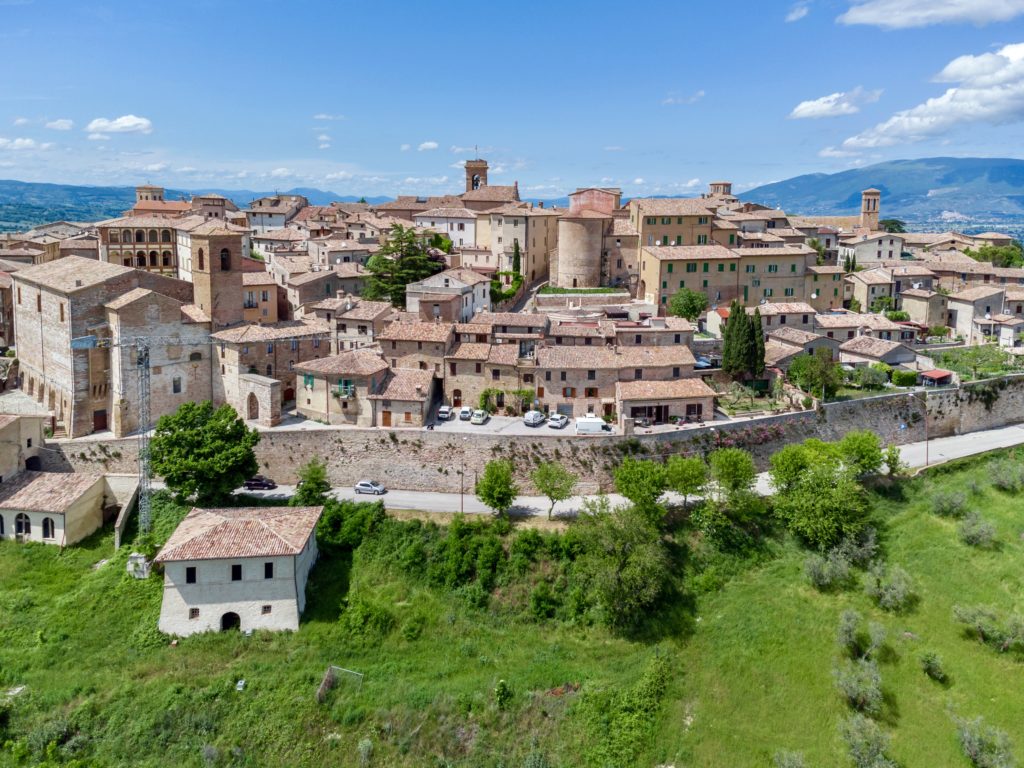
24. Montefalco, Umbria
Perched atop a mountain lining Italy’s Clitumnus Valley, Montefalco has also been called the Balcony of Umbria. It’s a village of great vistas.
From inside the walls of this tiny 14th century village, you can see for miles – to Perugia in the north and to Spoleto in the south.
The best view is from the Torre Communale. It’s an arduous climb, but the view at the top is worth it.
The Piazza del Communale is surrounded by amazing palaces built in the Middle Ages, such as Palazzo Langeli and Palazzo Comunale. It’s filled with coffee shops and wine bars. Seven streets radiate off the piazza.
Pay a visit to St. Augustine’s Church. It’s a massive Gothic church with faded frescos from the 14th to 16th centuries.
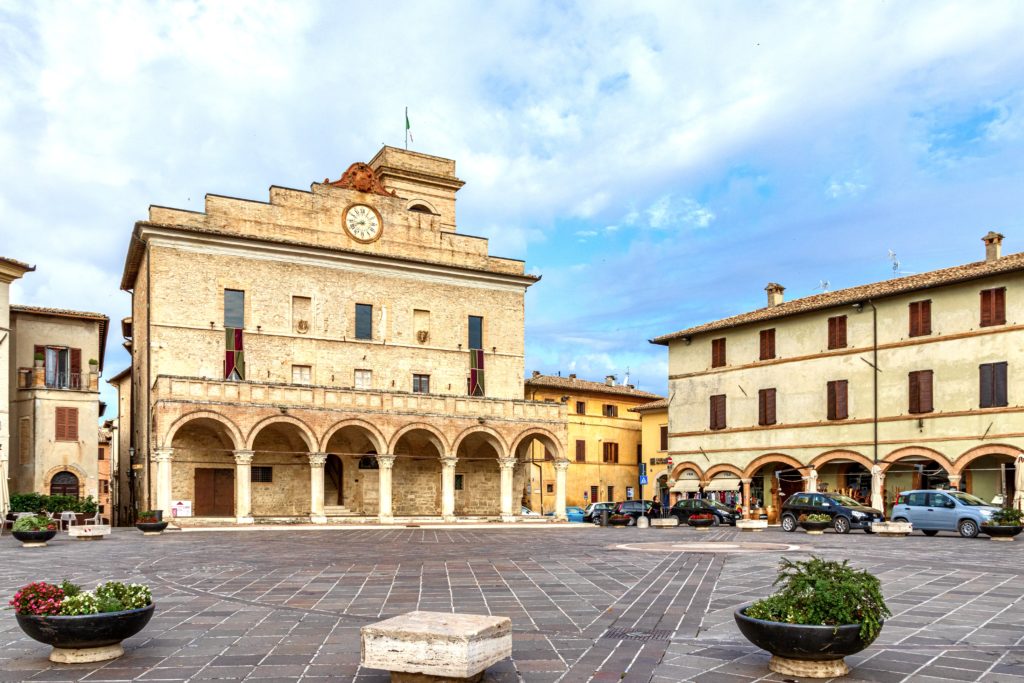
Montefalco also has a rather good museum for its diminutive size, the Museo di San Francesco. It’s housed inside a former 14th century Franciscan church.
You’ll find important work by Benozzo Gozzoli and Perugino. For example, Gozzoli painted scenes from the life of St. Francis and St. Jerome.
You may want to book a guided walking tour of Montefalco’s top medieval attractions.
Be sure to sample a glass of the town’s wine, Sagrantino. You can also book a wine tasting tour at a winery.
25. Montelupo, Tuscany
The underrated medieval town of Montelupo is tourist free hidden gem in Italy.
In the 13th century, Montelupo was a fledgling producer of intricate majolica, or tin-glazed ceramics, for the Medici dynasty. Certain patterns typical of Montelupo are still created today.
If you’re interested, I highly recommend a visit to the newly renovated Museo della Ceramica in Montelupo to get the full scoop.
In Montelupo’s colorful centro historico, you can find scads of tony shops with hand made artisan pieces. You won’t go home empty handed. The ceramics are too beautiful to resist.
Just make sure there’s an artist painting in the shop to ensure you’re getting a 100% local piece. You can even take a class from a master ceramicist.
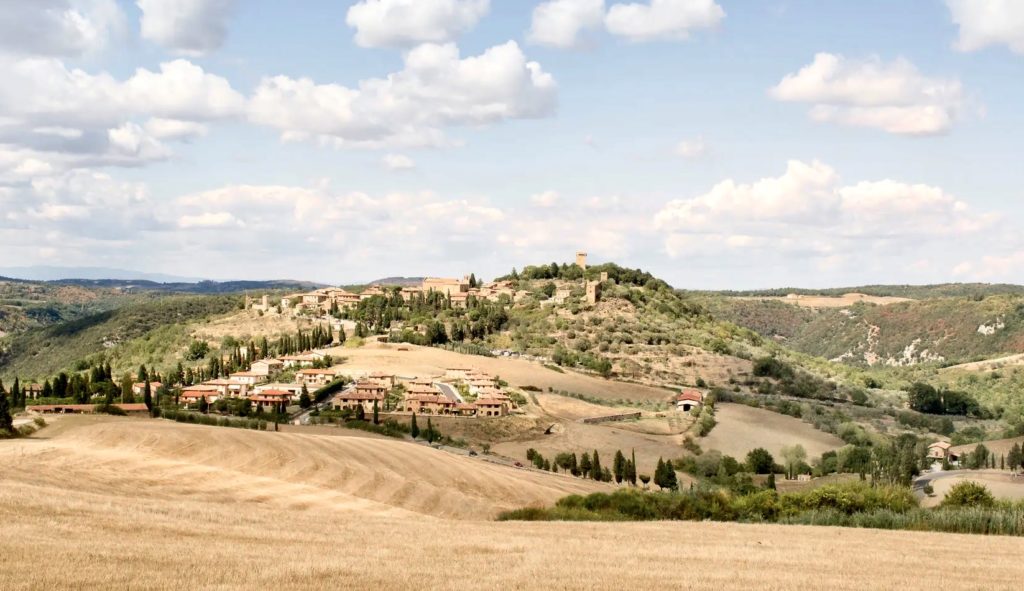
26. Monticchiello, Tuscany
Monticchiello is a sleepy fortified medieval village near the tourist magnet of Montepulciano in the Val d’Orcia region of southern Tuscany. Monticchiello lies along a dusty road meandering between golden rolling hills.
It’s a tiny village of just 200 residents, with eye catching ruins of the city walls and towers that date from the 13th century.
The town’s most impressive building is its church, the Pieve dei Santi Leonardo e Cristoforo, The church dates back to the 1200s and has a plain yet beautiful Romanesque-Gothic facade.
The other thing not to miss in the Monticchiello is the panoramic view just outside the main medieval gate. From there, you can see the neighboring town of Pienza.
Every summer, the population swells when the farmers and artisans of Monticchiello put on a drama of their own creation, Teatro Povero or Poor Theater. Every play is based on an event, real or legendary, in the life of the village.
Be sure to stop in for lunch or dinner at La Porta for some wine and tagliatelle with white truffles.
27. Monteriggioni, Tuscany
Monteriggioni is an idyllic walled town in the Tuscany. Just look how charming it is. It almost doesn’t look real.
Monteriggioni was built by Sienna in the 13th century as a defense in its ongoing conflict with its arch rival, Florence.
There’s an upper and a lower parking lot. It’s especially pretty in the early morning or at sunset.
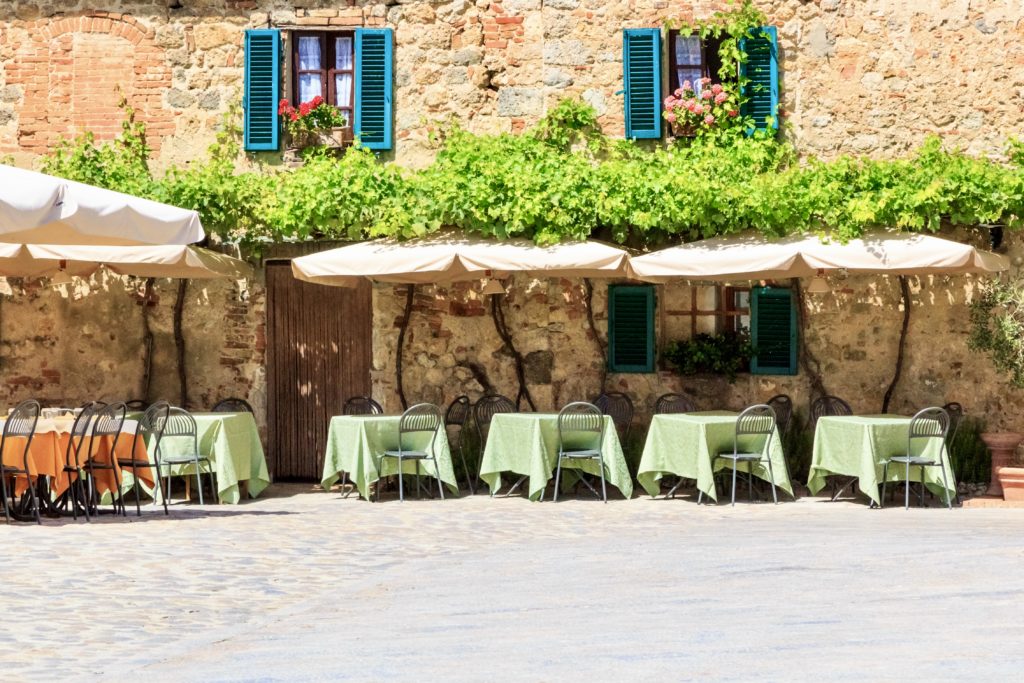
4 euros gets you entry to the walls and the museum onsite. You only need an hour or two. If you want to have lunch or dinner, try Il Pozzo.
If you’re a fan of Assassin’s Creed, you’ll be glad to know that Monteriggioni is real (though much smaller than depicted there).
The town also makes an appearance in Dante’s Divine Comedy. Dante compares the spiky turrets of Monteriggioni to giants surrounding the abyss.
You can visit Monteriggioni on a guided day trip from Florence or a hiking tour from Siena.
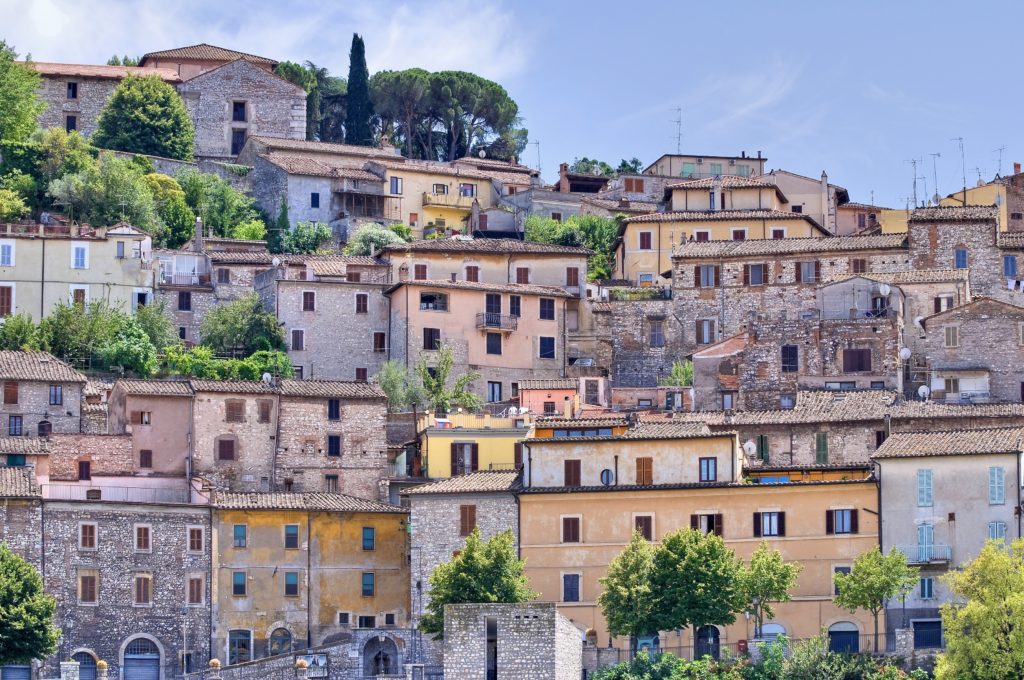
28. Narni, Umbria
Narni is a tiny hamlet, tucked away in a lush, almost wild, landscape. It was built on a rocky spur overlooking the Nera Gorge.
The town’s medieval heritage is entirely intact. You can wander through the charming squares and narrow streets and climb the stone steps.
Narni Fortress, the Rocca, dominates the whole town. It was built by Cardinal Albornoz as a symbol of papal power.
The central square is Piazza Garibaldi. This is where you’ll find the Narni’s 11th century Duomo. It has a simple facade with an elegant arched portico.
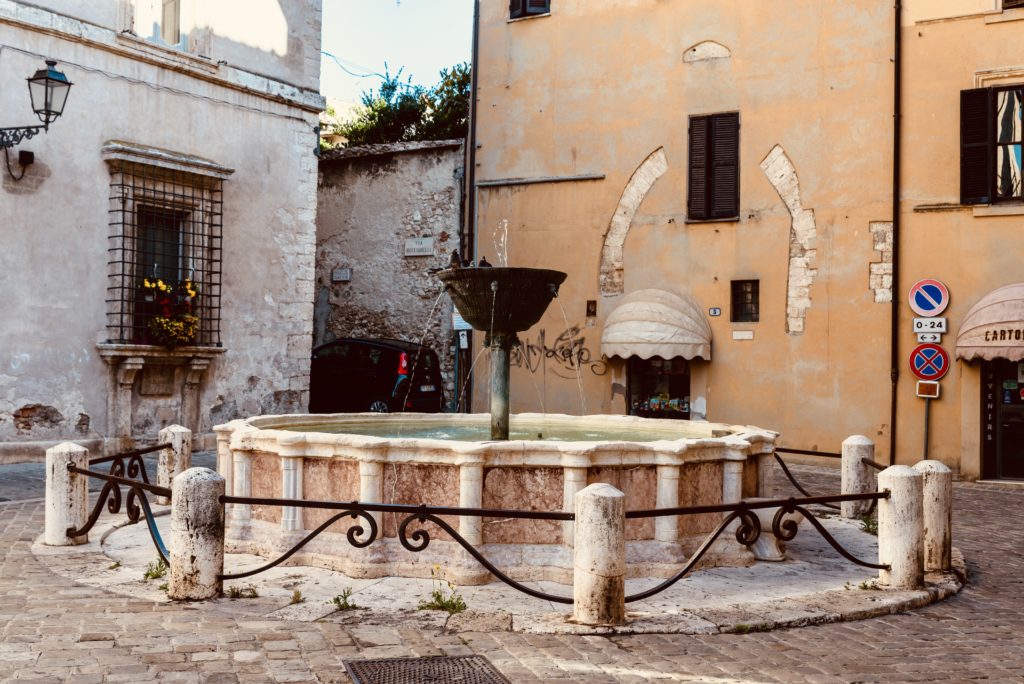
The Piazza dei Priori is home to both the Palazzo dei Priori and the Palazzo del Podesta (the Town Hall).
Like Orvieto, Narni has a network of underground sites, Narni Sotterranea. It was only discovered in 1979.
You can see a 12th century chapel smothered in frescos, secret tunnels, an Inquisition torture room, and a prison cell covered in graffiti.
If you’d like to book a walking tour, this 2 hour guided tour covers Nani’s history and attractions.
If you need to grab a meal in Narni, try Rustico or Osteria Monte del Grano.
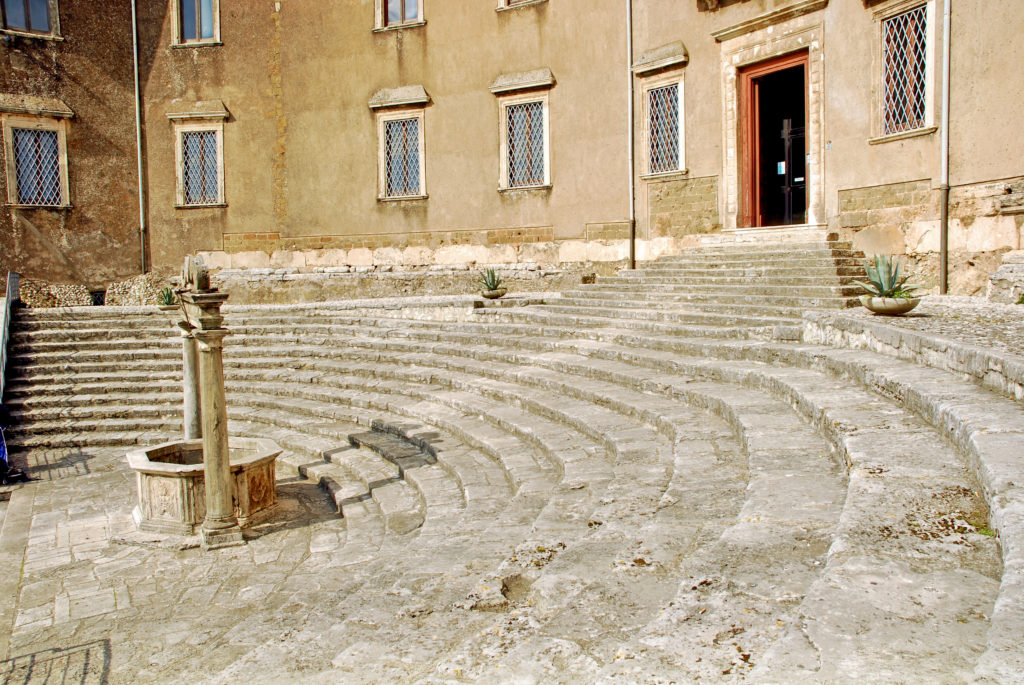
29. Palestrina
Palestrina is hidden gem in Italy for history buffs and ruin lusters. The entire town is built over and into the ruins of an enormous ancient temple.
Originally a significant Etruscan town, Palestrina became renowned for its massive Temple of Fortuna Primagenia. The shrine dates from the 2nd century B.C. In antiquity, this temple was one of the largest and most visited temples in Italy.
The temple ruins were only discovered after WWII bombings exposed the ancient foundations.
The former sanctuary of the temple was later transformed into the Palazzo Colonna-Barberini. The 17th century palace now houses the very fine Museo Archeologico. It’s situated at the highest point of the town and is hard to miss.
It’s worth a visit for the museum alone. It houses a large and well-labeled collection of Etruscan bronzes, terra cotta statuary, pottery, and some Roman artifacts. The star of the show is a 1st century B.C. mosaic representing the river Nile in flood.
30. Pienza, Tuscany
Pienza is a hidden gem in Italy located in the gorgeous Val d’Orcia region of southern Tuscany, where cypress trees line winding roads and sun-bleached valleys.
Pienza is known as the first “ideal Renaissance town.”
It was the brainchild of Enea Silvio Piccolomini, who would later become Pope Pius II. To accomplish this feat, Piccolomini hired the architect Bernardo Rossellino.
The result was a town that perfectly expressed the Renaissance canons of art and architecture.
READ: Best Things To Do In Pienza
The heart of Pienza is its main square, the splendid Piazza Pio II. It’s wrapped with Pienza’s most impressive monuments.
Pienza Cathedral has classically-inspired marble facade that recalls ancient Roman triumphal arches.
The Piccolomini Palace was the domestic summer residence of the Piccolomini family. It has a beautiful courtyard and loggia on the second floor. From the loggia, you have breathtaking panoramas of Mount Amiata and the Val d’Orcia.
Pienza makes a great base for exploring southern Tuscany. The town is small and eminently scrollable. It has some great restaurants and plenty of things to do and see.
You can book an 8 hour guided tour of Montepulciano and Pienza from Florence. There’s also a private wine tour from Siena.
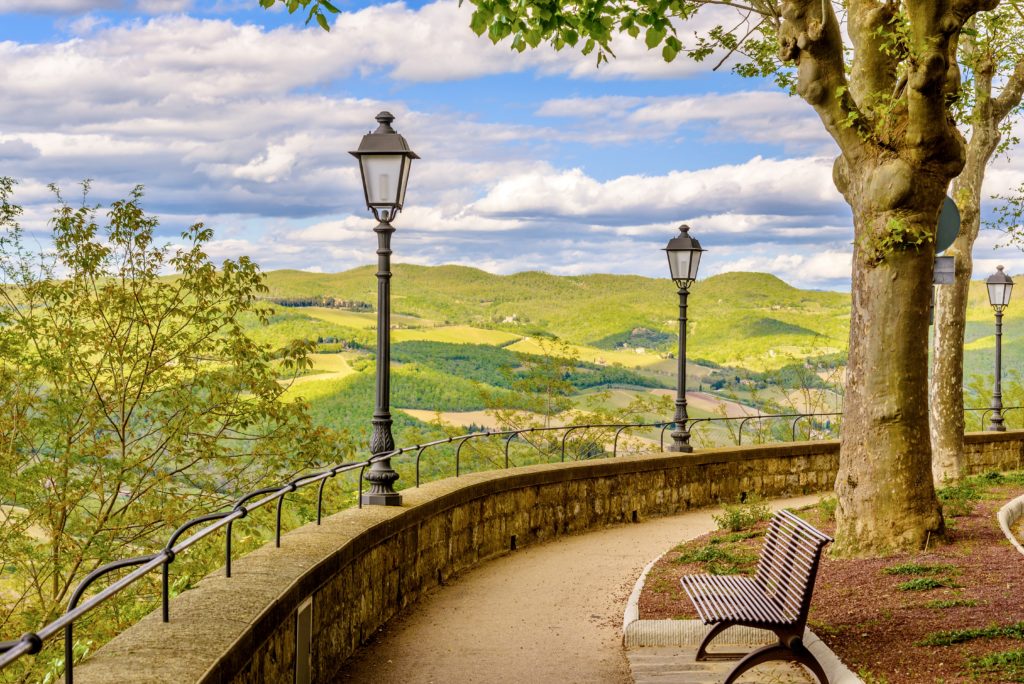
31. Radda in Chianti, Tuscany
Radda is a classic Tuscan town right in the middle of the Chianti Classico region. It’s on a hill, set above vineyards in a wrenchingly beautiful landscape.
Radda was once the seat of the League of Chianti, where the podesta administered the territory from Radda’s town hall, the Palazzo del Podesta on the main street.
In Radda, narrow alleys with views across the vineyards bisect the still partly walled medieval town. The town is dominated by the Church of San Niccolò, with a lovely portico.
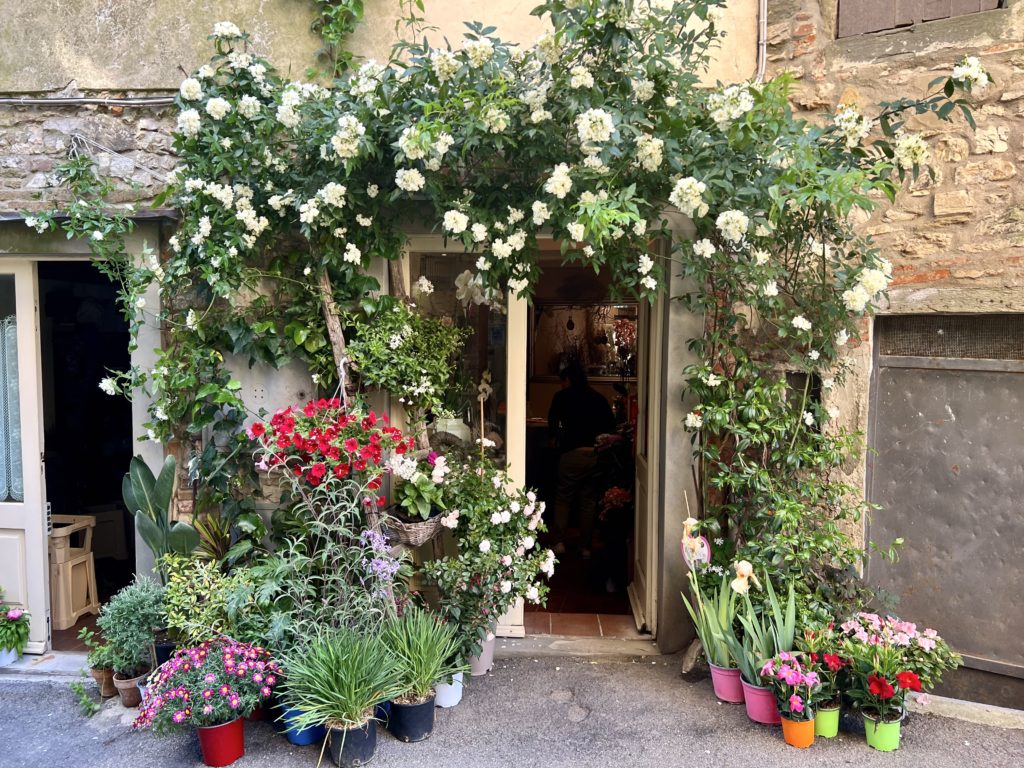
As you might expect, Radda has plenty of wine bars and wine-centric restaurants.
While in Radda, it only makes sense to visit a local winery or go on a guided wine tour.
Just 20 minutes from Radda is Badia a Coltibuono. It’s an ancient 11th century abbey nestled on the hillside of the Monti del Chianti. I had one of my best meals in Tuscany at the Badia.
32. Sansepolcro, Tuscany
Sansepolcro is a compact walled town in southern Tuscany, with red tiled roofs and a cache of great art. The name Sansepolcro translates as “holy sepulcher.” The town allegedly owns parts of the sepulcher (tomb or monument), in which Christ was entombed.
It has 14th century city walls, medieval charm, and a fine art museum.
Sansepulcro was the birthplace of early Renaissance pioneer Piero della Francesca. If you are on the Piero della Francesca trail, you should definitely visit.
The Civic Museum holds one of the most important art troves in Tuscany outside Florence. It houses two of Piero’s finest works — the Madonna della Misericordia and Resurrection.
You might be standing all alone looking at them, that’s now much of a hidden gem in Italy the town is.
Around the corner from the museum is the town Cathedral. You’ll find 15th century frescos.
33. Ravello, Amalfi Coast
Called the “mountain pearl,” Ravello vies for the crown in the competition for the most beautiful town on the Amalfi Coast.
Suspended between the sky and sea, Ravello is ravishing. It has mesmerizing coastline views and pretty beaches.
Ravello can seem like a world removed from the clamor of the “1000 bends” Amalfi Drive. As a bonus, it’s less crowded than other Amalfi towns because it doesn’t have as many public transport options.
The heart of Ravello is in the Piazza del Vescovado and the Piazza del Duomo. Ravello’s Duomo was founded in the 11th century and boasts some beautiful mosaics in the pulpit.
But Ravello is all about the views. Visit the Terrace of Infinity in the gardens of Villa Ciambrone.
It’s a dizzying and memorable vista over the terraced mountains and sea. The terrace is decorated with Roman-style statuary along the fence.
The Villa Rufolo gardens also have magnificent views. The lower terrace garden is known as the Wagner Terrace and holds a Wagner Festival in the summer.
If you need some exercise, Ravello delivers. From Ravello, you can hike to the Monastery of Saint Nicholas, Amalfi, Minori, or Maiori.
You can book a guided tour to Ravello from Sorrento or a tour from Naples.
READ: 2 Days In Ravello Itinerary
34. Ravenna, Emilia-Romagna
If you’re an art lover, you should visit the hidden gem of Ravenna. The town is a glittering jewel box of 5th and 6th century mosaic art.
The city owns some of the world’s most important Byzantine mosaics. The poet Dante described Ravenna’s mosaics as “the sweet color of Oriental sapphires.”
Ravenna was once the epicenter of the Western World, when the Byzantine Empire made Ravenna its capitol. The Byzantine rulers decorated Ravenna’s churches with gorgeous mosaics.
This artistic legacy rivals, or even surpasses, that of Venice and Istanbul. Ravenna has a whopping 8 UNESCO sites to explore.
What you see in Ravenna is the transformation from the Roman world to the early Byzantine world. Byzantine art moved away from classical ideals and naturalism.
To get the full scoop, here’s my complete guide to the mosaics of Ravenna. I also recommend booking a private walking tour.
35. Royal Palace of Caserta
If you’re on the UNESCO trail in Europe, you may want to carve out time for he incredible Palace of Caserta. It’s a UNESCO site just 30 minutes north of Naples that may remind you of Versailles.
The palace was built by King Charles VII of the House of Bourbon. It was used as the main residence of the kings of Naples.
With over 1200 rooms, the palace was one of the largest palaces in 18th century Europe. The sprawling palace complex was built on a grid with four outer wings.
You enter via the Grand Staircase of Honor, surrounded by marble. The palace is lavish inside, especially the gold-filled throne room.
You can visit the palace on a day trip from Naples. Or visit the palace on a guided tour with an art expert.
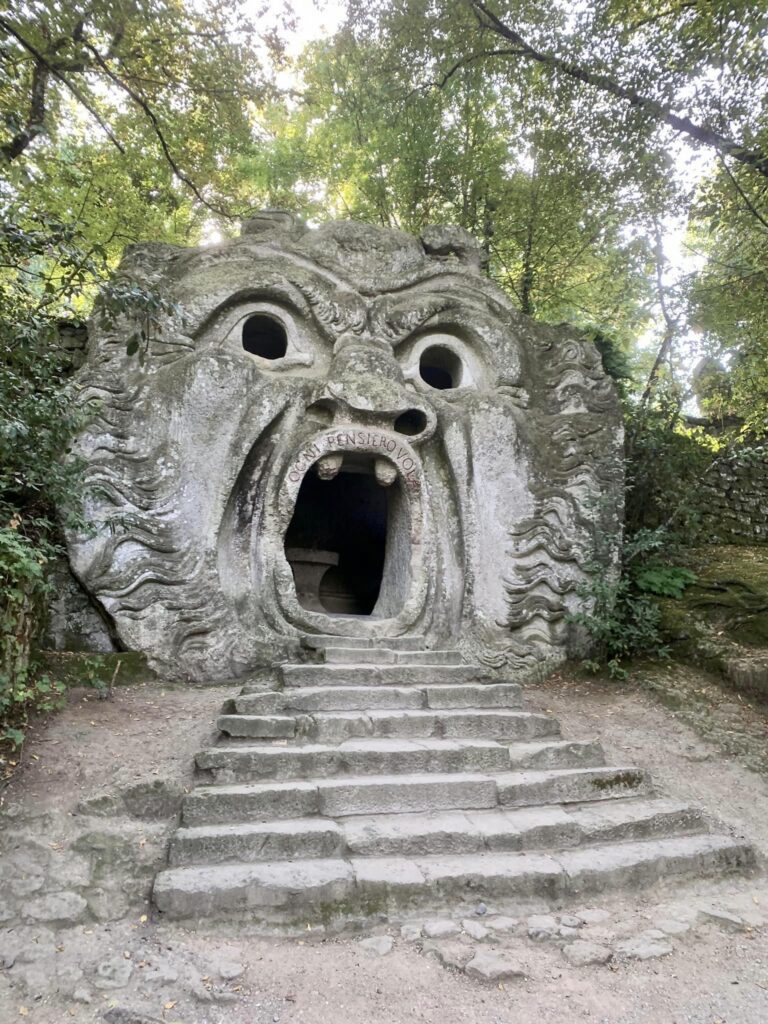
36. Sacred Park of Bomarzo, Lazio
The Sacred Park of Bomarzo is a unique garden in the Lazio region of Italy. More commonly known as the Park of Monsters, it was commissioned by the 16th century Italian nobleman, Pier Francesco Orsini.
The 30 main sculptures were created by the architect and sculptor, Pirro Ligorio, who also had a hand in designing the famed Villa d’Este.
The sculptures depict mythical creatures, monsters, and other surreal figures. They are scattered throughout a natural landscape of hills, trees, and flowers.
Some of the most famous sculptures include a giant elephant with an obelisk on its back, a dragon with a gaping mouth, a giant turtle, and a house with tilted walls.
The park was intended to be a place of wonder and contemplation. Today, the park is open to the public and is a designated national monument. It’s a unique and unforgettable hidden gem in Italy for anyone interested in art, history, or the strange and unusual.
>>> Click here to book a guided tour of the park
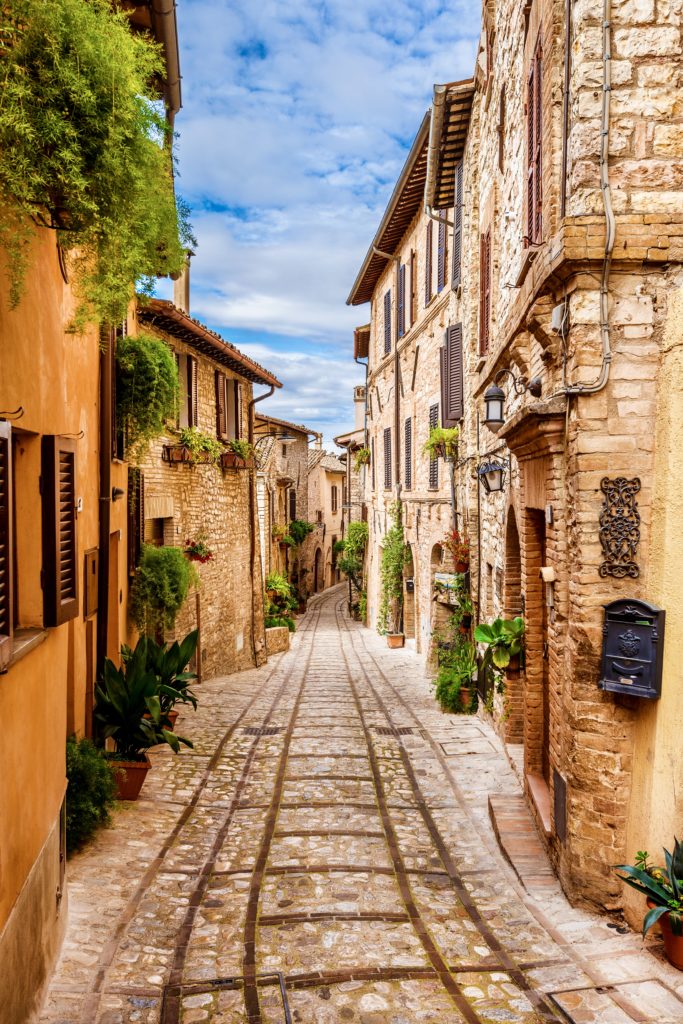
37. Spello, Umbria
Spello is a stunning village with cobbled streets and flowers galore, about 45 minutes from Gubbio in Umbria. It holds the official designation of one of Italy’s most beautiful villages.
Every street in Spello is a postcard perfect feast for the senses. The town seduces with winding medieval streets, crumbly old churches, and Roman ruins.
You’ll be dazzled by rose-colored stone walls, bright terracotta roof tiles, stone pathways, and weathered wooden doors.
The Church of Santa Maria Maggiore is the top attraction in Spello. It houses a Madonna and Child and a Pietà by Perugino.
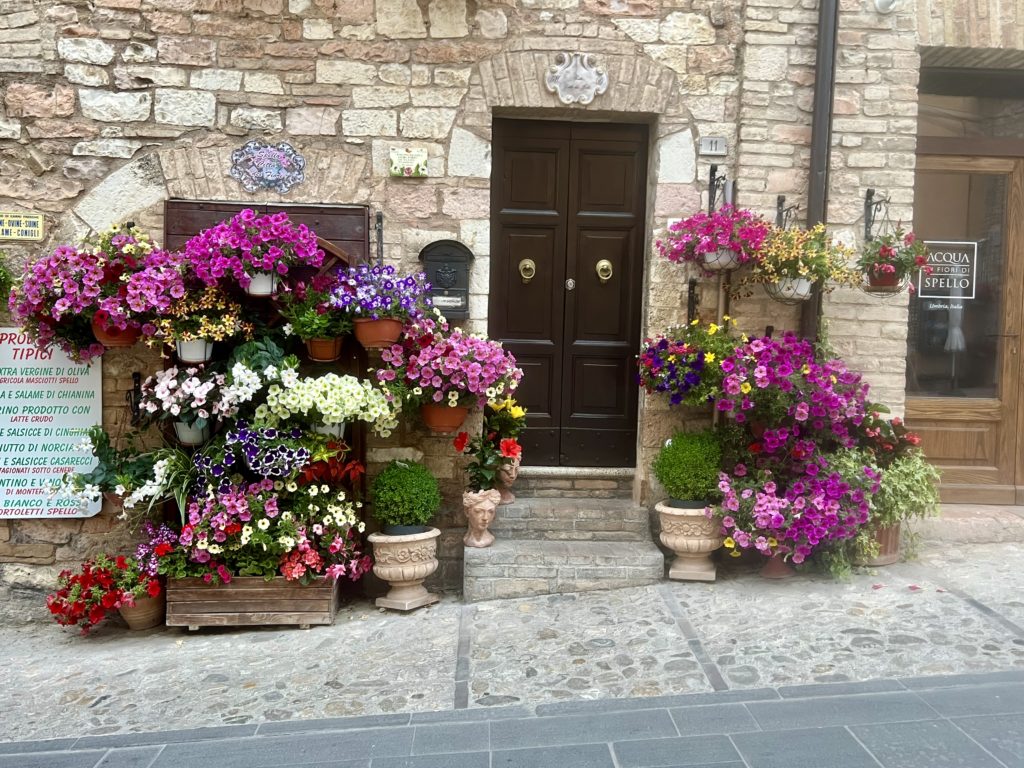
You can also visit the spectacular Baglioni Chapel. It closes at 4:00 pm, so make sure you arrive in Spello before then and make it your first stop.
The chapel is famous for its 16th century Renaissance frescos by Pinturicchio, telling stories of the life of Mary and Jesus. The chapel also has a pavement of Deruta ceramics.
You should also visit the Villa of Mosaics. Discovered by chance in 2005, it’s one of the most important archaeological discoveries of the last 20 years. For a real feel of how old Spello is, you can combine the villa with a walk along the Roman aqueduct.
To learn about Spello’s Renaissance masterpieces, you can book a guided walking tour.
READ: One Day in Spello Itinerary
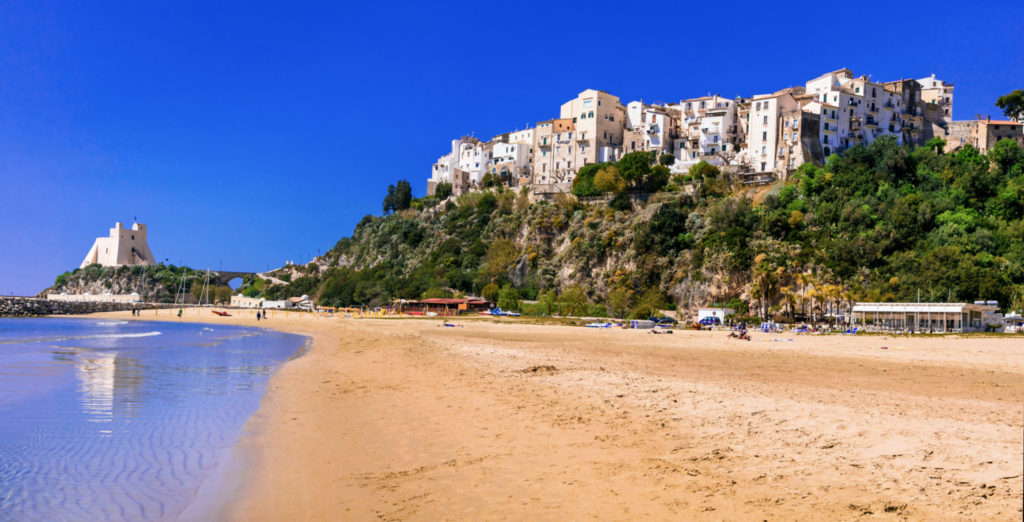
38. Sperlonga, Lazio
Sperlonga is an extremely pretty “do nothing” beach town. It’s about 80 miles south of Rome in Italy’s Lazio region. To most Americans, it’s a hidden gem in Italy that they haven’t heard of it. But the locals love it.
The old town is a whitewashed warren of passageways and staircases. You’ll find cafes and shops, decked out in flowers. There’s a view of the broad sandy beaches from a piazza at the very top.
You can visit the grandiose Villa of Tiberius, built by the Emperor Tiberius. Among the ruins was a grotto with colossal statuary dedicated to the Greek hero Ulysses. A connected museum now holds the ancient sculptures.
You can also hike up to the Truglia Tower. This medieval tower was built in the 17th century to protect Sperlonga from pirate attacks.
The tower stands out like a strange, geometric sentinel atop a hill overlooking the Tyrrhenian Sea. The vantage point offers spectacular views of the sea and beaches below.
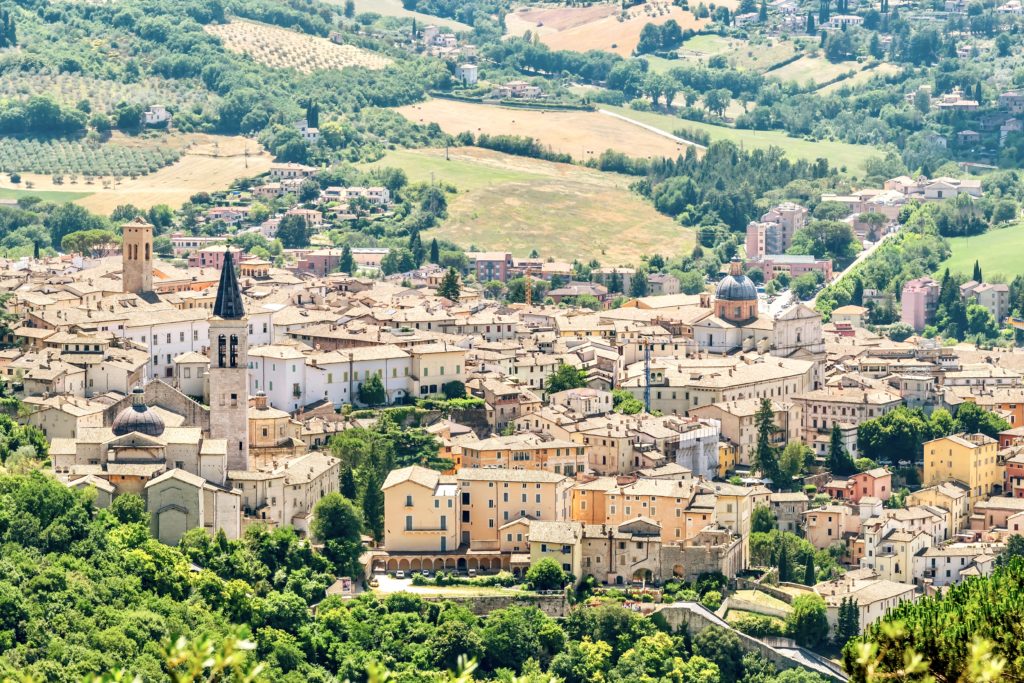
39. Spoleto, Umbria
Spoleto is a gorgeous and endlessly intriguing secret Umbrian hill town. Presided over by a formidable medieval fortress and backed by the broad-shouldered Apennines, Spoleto is visually stunning.
The Etruscans and Romans each left their tangible ruins — a Roman amphitheater, a 4th century house, and a simple 6th century Roman church.
Spoleto’s pale stone Duomo is photogenically set on a graceful hillside piazza. The exterior is a mix of Romanesque and Renaissance styles.
The interior received a 17th century Baroque facelift. You’ll see a beautiful Cosmati marble floor and frescoes by Pinturicchio and Fra Lippo Lippi.
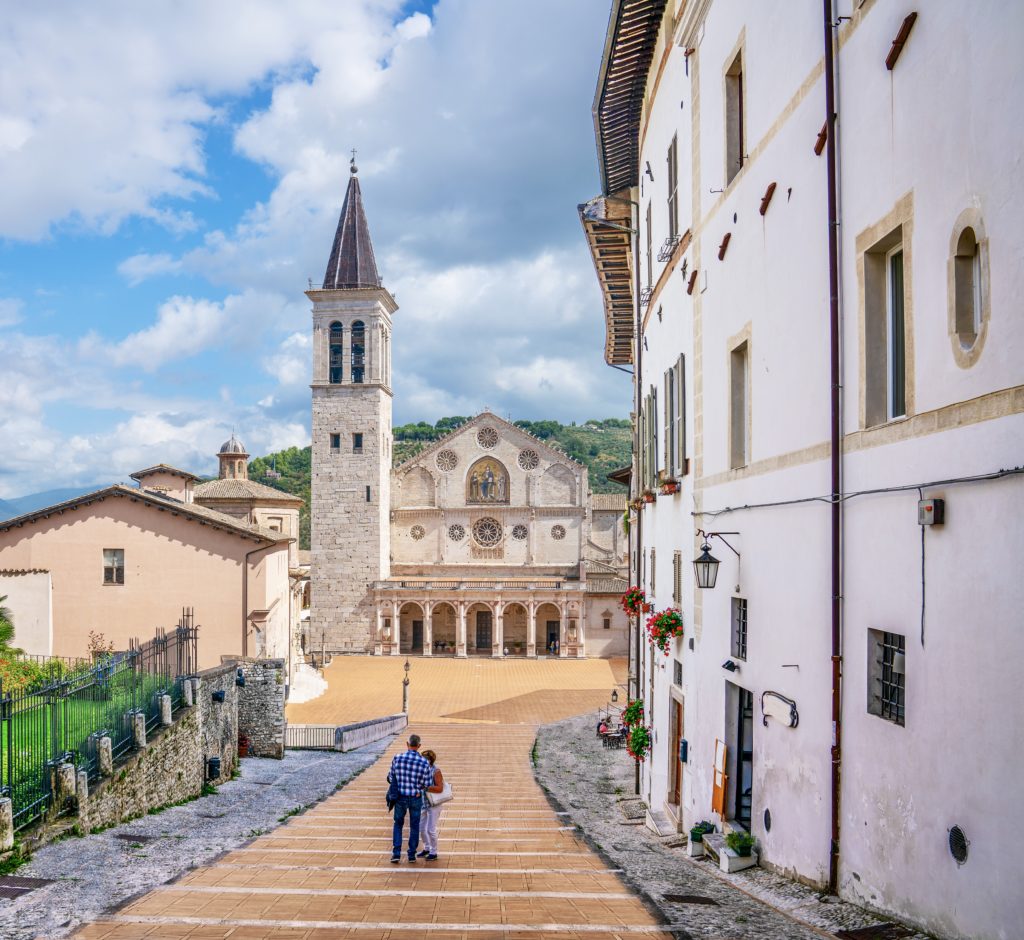
The other attention grabber in Spoleto is the Ponte delle Torri. It’s a 10 arch bridge that spectacularly spans a steeply wooded gorge.
Spoleto is famous for its Festival dei Due Mondi, Spoleto Festival. It’s one of Europe’s most beloved carnivals with contemporary music, art, dance, and theater.
There are stunning online photos of some 15,000 or so attendees crammed into the piazza in front of the Duomo. But this is a spectacle I have seen only on postcards.
>>> Click here to book a guided walking tour of Spoleto
READ: Best Things To Do In Spoleto
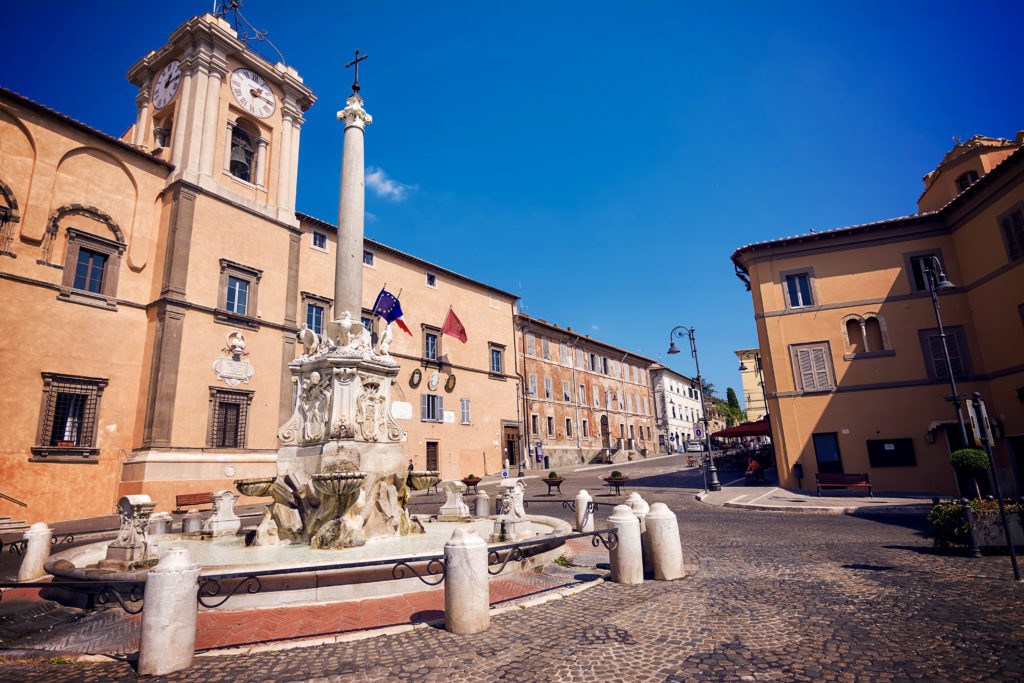
40. Tarquinia, Lazio
The UNESCO-listed Necropolis of Tarquinia is one of Italy’s most magnificent Etruscan sites. The “city of the dead” is pre-Roman. It dates back to the 7th century B.C.
For 300 years, until 500 B.C., Tarquinia was the master of Rome and central Italy. Tarquinia boasts some of the best preserved Etruscan sites in the world.
Since 1489, nearly 6,000 tombs have been excavated. The most important tombs are the Tomb of the Shields, the Tomb of the Lioness, and the Tomb of the Warrior. There are 140 fantastic large scale wall frescos behind plexiglass.
The medieval town of Tarquinia is itself quite charming, sprawling on a hill overlooking the sea. You can visit the National Museum of Tarquinia, housed in the Gothic-Renaissance Palazzo Vitelleschi.
At the Piazza del Duomo, you can admire the town’s Cathedral of Santa Margherita. The Romanesque Church of St. Francis also deserves a visit.
Click here to book a guided tour.
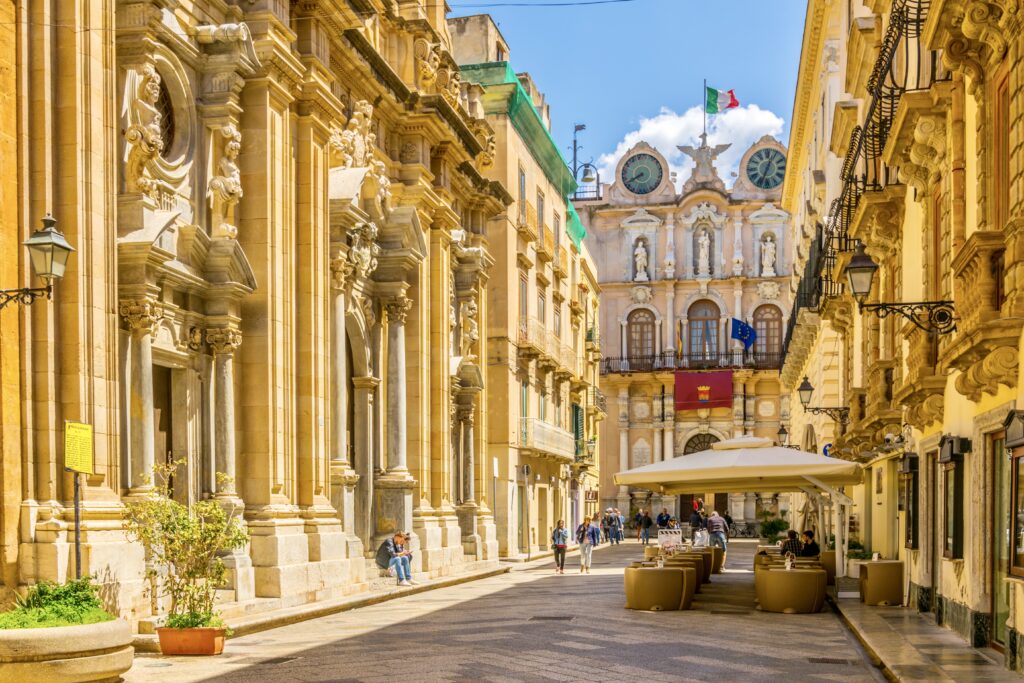
41. Trapani, Sicily
If you’re looking for a sun-drenched coastal town that’s a bit off the beaten path, Trapani might just be the perfect destination.
With its stunning honey-colored Baroque architecture, the old town is like a living art book. Don’t miss strolling down the picturesque streets of Corso Italia, Corso Vittorio Emanuele, and Via Garibaldi.
While you’re in Trapani, make sure to check out the impressive Trapani Cathedral. And, for a taste of local culture, head over to the Church of the Holy Souls of Purgatory.
Trapani’s bustling port area is also a must visit, with a stunning waterfront and restaurants serving up delicious Mediterranean cuisine and fresh seafood.
One of the best things about Trapani is its convenient location for exploring western Sicily. From the city, you can easily visit natural wonders like the cliff town of Erice or the ancient ruins of Segesta.
READ: 2 Days in Trapani Itinerary
42. Treviso, Veneto
If you were put off by Venice’s crowds, try the oasis next door. Treviso is an elegant little town, only a 30 minute train ride from Venice. It’s one of northern Italy’s undiscovered hidden gems.
With its fortified medieval walls, Trieste is criss-crossed with its own set of picturesque canals set amid waterwheels.
Treviso is vastly less crowded than Venice and eminently more authentic. The main square is Piazza dei Signori. It’s highlights are the Palazzo del Podesta and the Palazzo dei Trecento.
You can roam the narrow medieval streets and maze of back alleys and poke into Gothic churches. Many of them were frescoed by Giotto follower Tomaso da Modena.
Stop in at Cantinetta Venegazzu or All’Antico Pallone for an apertivo or late night cocktail. The restaurant that lays claim to inventing tiramisu, Le Beccherie, is just opposite.
43. Viareggio, Tuscany
If you yearn to see the Mediterranean sea, the hidden gem of Viareggio is your best bet. Viareggio is a beautiful beach town that’s often passed up in favor of the Ligurian or Amalfi Coast.
The town has a majestic stretch of the Apuane Alps behind it. You can look back from the water’s edge and over the city’s buildings and take in the picturesque backdrop.
Aside from the beaches, you can enjoy the Viareggio’s beautiful “Liberty” (Art Nouveau) architecture. There are also plenty of shops, restaurants, and cafes to keep you busy. You can also book a market and food tour.
The beaches in Viareggio are, like most beaches in Tuscany, private. You have to pay a fee to enter and rent an umbrella and lounge chairs, which stretch nearly as far as the eye can see.
In February, Viareggio becomes animated with its famous Carnevale festival and parade. If you want to attend (weekends only), you must book tickets online.
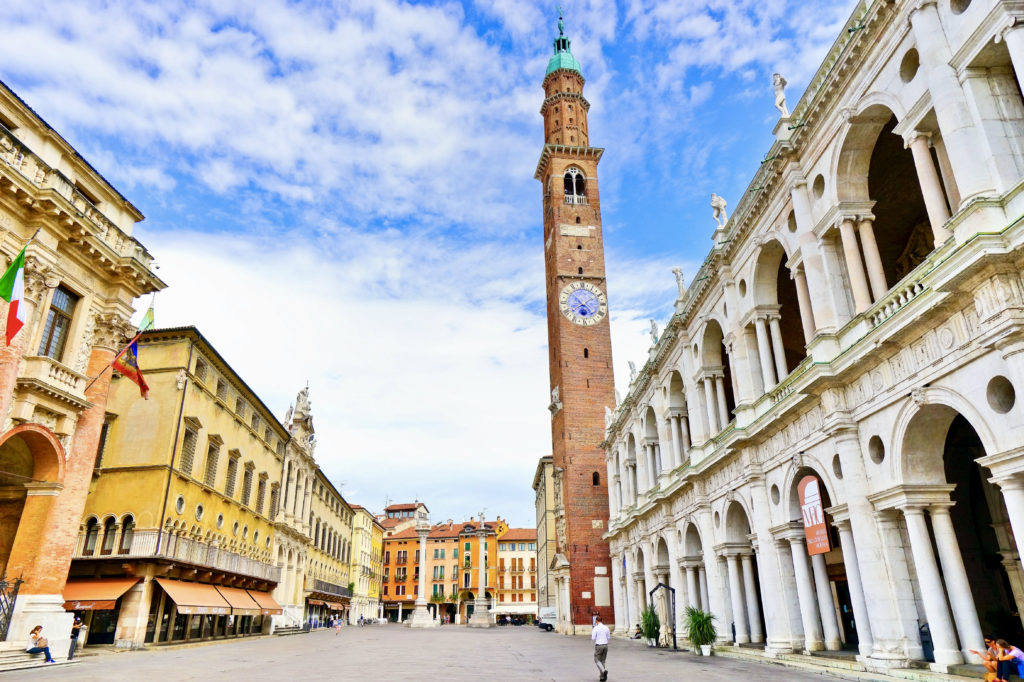
44. Vicenza
Despite making the UNESCO list, Vicenza is still a hidden gem in Italy. The town was the crucible of the celebrated Andrea Palladio, one of the world’s greatest architects.
Palladio created elegant buildings. With their graceful proportions, they looked like Greek temples.
If you’re an architecture geek, Vicenza will appeal. The city is variously known as the “Pearl of the Renaissance,” the “Gold City,” and the “City of Palladio.”
But Vicenza isn’t exclusively for architecture buffs.
The city is lovely in and of itself. Vicenza’s streets are a dense jumble of creamy pastel buildings, small canals, quaint churches, and cobbled alleys.
The Corso Andrea Palladio is Vicenza’s pedestrianized main street that pays homage to Palladio. It’s the main streets in the historic old town, brimming with magnificent buildings and palazzi.
The main things to see are Piazza dei Signori, Basilica Palladiana, Palazzo Chiericati, and the magnificent Olympic Theater.
To see it all, You might want to book a 2.5 hour walking tour of Palladio’s masterpieces or a 1.5 hour walking tour with a local.
READ: Best Things To Do In Vicenza
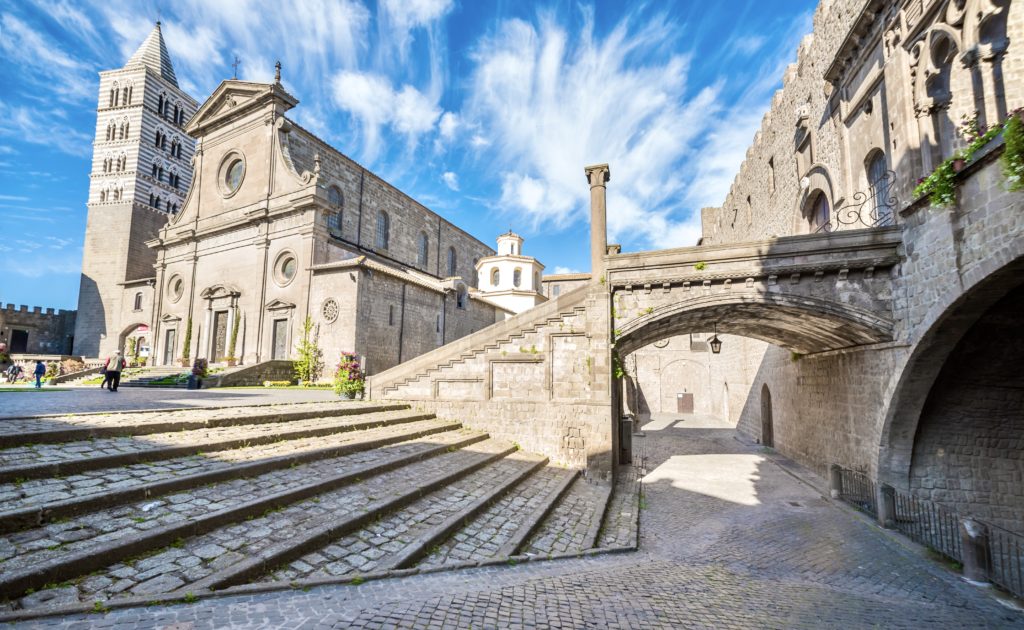
45. Viterbo, Lazio
Underrated Viterbo is a beautiful medieval gem just an hour from Rome. Viterbo was at its zenith in the 13th century, when it overshadowed Rome itself as a center for papal power.
Viterbo is almost entirely surrounded by incredibly well kept walls and has an intact medieval center. The San Pellgrino district is one of the best preserved neighborhoods in Italy.
The Gothic Palazzo Papale was built in the 13th century as a residence for popes looking to get away from Rome. The escape palace was the site of the first ever conclave to elect a new pope.
The interior isn’t always open. But you can climb the stairs to admire what was once the loggia.
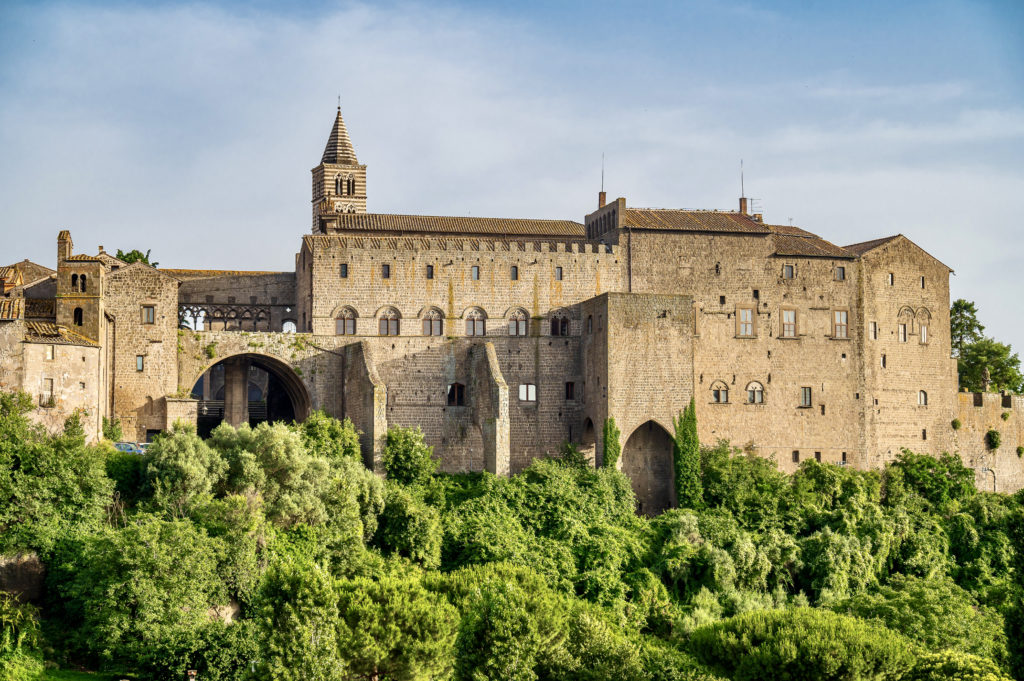
Viterbo is also a spa town. you can have a local volcanic mud bath or steam in an ancient cave at Terme dei Papi.
>>> Click here to book a guided walking tour of Viterbo
I hope you’ve enjoyed my guide to the hidden gems and secret towns in Italy. You may enjoy these other Italy guides:
- 5 day itinerary for Rome
- Hidden gems in Rome
- 1 day itinerary for Vatican City
- 3 day itinerary for Florence
- 2 day itinerary for Venice
- 1 day itinerary for Milan
- 1 day itinerary for Siena
- Things To Do In San Gimignano
- 10 day itinerary for Tuscany
- 1 week itinerary for Umbria
- 10 day itinerary for Italy’s classic cites
- 12 ways to spend 1 week in Italy
If you’d like to explore Italy’s hidden gems, pin it for later.
